Learning from the Best and Worst: Problems, Prospects and Policy Implications from Global Benchmarking of Urban Passenger Transport Sustainability in Greater Manchester and the Leicester Metropolitan Area, UK
Abstract
1. Introduction
2. Literature Review of the Background and Utility of Comparative Cities Research on Automobile Dependence
2.1. General Background
“In general, benchmarking is considered as a systematic tool that allows an organization to determine whether its performance of organizational processes and activities represents its best practices…The benchmarking should answer:—What are benchmark’s partners doing that you are not doing? What can you do to achieve similar and still better results? Realization of benchmarking is a very complex process that includes understanding of one’s own organization and performance, and identifying and learning from best practices of other organizations…”
2.2. Selected Previous Findings on Key Comparative Indicators Central to This Study
3. Methodology
3.1. A Brief History of This Paper’s Global Cities Comparative Research
- Stage I: 1978 to 1981
- Stage II: 1982 to 1984
- Stage III: 1985 to 1991
- Stage IV: 1992 to 1997
- Stage V: 1998 to 2002
- Stage VI: 2003 to 2015
- Stage VI: 2016 to present
3.2. Background of the Paper’s Global Cities Data Collection
3.3. The Current Study
|
|
|
|
|
|
|
|
|
|
|
|
|
|
|
|
|
|
|
|
|
|
|
|
|
|
|
|
|
|
|
Items 32 to 35 are essential in depicting the overall modal split of daily trips in cities, especially since they add the only data on walking and cycling trips in this study. With extra work, the average walking and cycling trip distances can be collected to calculate passenger kilometres, which can then be combined with cars, motorcycles and public transport passenger kilometres to produce an alternative modal split picture for all cities based on what percentage each mode contributes to total passenger movement. |
| Land Use Category | Type | Comment |
|---|---|---|
| Agricultural | n/u | |
| Meadows, pastures | n/u | |
| Gardens, local parks | u | These areas are not generally built up, but in their size, they are too small and in their human recreational uses, they are too intense to qualify as genuine non-urban land. |
| Regional scale parks | n/u | These are large, contiguous areas set aside within metropolitan areas for non-intensive or restricted recreational uses, water catchment functions, green belts, etc. |
| Forest, urban forest | n/u | Urban forests are larger than parks and are often significant wildlife and forestry areas. |
| Wasteland (natural) | n/u | This includes flood plains, rocky areas, and the like. |
| Wasteland (urban) | u | This includes derelict land, culverts, etc. |
| Transportation | u | Road area, railway land, airports, etc. |
| Recreational | u, n/u | Depending on the intensity of use, this group can belong partly in either category. Golf courses are urban, as their use is intense. Mostly, recreational land is considered urban. |
| Residential, industrial, offices, commercial, public utilities, hospitals, schools, cultural uses, sports grounds | u | |
| Water surfaces | n/u |
4. Results and Analysis: An International Comparison of Greater Manchester and the Leicester Metropolitan Area with a Global Sample of Cities
4.1. Land Use, GDP and Private Transport Infrastructure Characteristics
4.1.1. Urban Density
4.1.2. Proportion of Jobs in the CBD
4.1.3. Metropolitan Gross Domestic Product (GDP) per Capita
4.1.4. Road Length per Capita and per Hectare
4.1.5. Freeway Length per Capita and per Hectare
4.1.6. Parking Spaces per 1000 CBD Jobs
4.1.7. Passenger Cars and Motorcycles per 1000 Persons
4.1.8. Average Road System Speed
4.2. Public Transport Infrastructure and Service
4.2.1. Public Transport Line Length per Person
4.2.2. Reserved Public Transport Route Length per 1000 Persons
4.2.3. Public Transport Vehicle Fleet per Person
4.2.4. Public Transport Vehicle Kilometres (VKT) of Service per Person
4.2.5. Public Transport Seat Kilometres (SKT) of Service per Person
4.2.6. Average Public Transport System Speed
4.3. Public Transport Use
4.3.1. Annual Public Transport Boardings per Person
4.3.2. Public Transport Passenger Kilometres per Person
4.3.3. Public Transport Vehicle Occupancy
4.3.4. Public Transport Seat Occupancy
4.4. Car and Motorcycle Use and Modal Split
4.4.1. Non-Motorised Modes Modal Share
4.4.2. Public Transport Modal Share
4.4.3. Modal Share by Private Transport Modes
4.4.4. Car Use per Person
4.4.5. Motorcycle Use per Person
4.5. Private–Public Transport Balance Indicators
4.5.1. Proportion of Total Motorised PKT on Public Transport
4.5.2. Public Versus Private Transport Average Speed
4.5.3. Reserved Public Transport Route Versus Freeways
4.6. Some Transport Outcomes
4.6.1. Private Passenger Transport Energy Use per Capita
4.6.2. Public Transport Energy Use per Capita
4.6.3. Transport Emissions per Capita and per Hectare
4.6.4. Transport Fatalities per 100,000 Persons
4.7. Some Economics of Public Transport
4.7.1. Public Transport Farebox Revenue per PKT
4.7.2. Public Transport Operating Cost per PKT and per VKT
4.7.3. Cost Recovery of Public Transport
4.7.4. Percentage of Metropolitan GDP Spent on Operating Public Transport
5. Discussion and Policy Implications
5.1. Discussion
- The length of freeway per person in both cities was only moderate.
- The parking supply in both cities’ CBDs was moderate and quite like other European cities. However, the percentage of metropolitan jobs located in the CBDs was very low compared to other European cities, suggesting much more job decentralisation which encourages car use.
- The percentage of daily trips by walking and cycling in both UK cities is similar and healthy, though it is below both the Swedish and other European cities. Of concern though is the fact that cycling represents only a very tiny fraction of non-motorised mobility in both UK cities, so that there is little substitution of car travel by bikes.
- Both cities have low public transport system coverage (line length per person) compared to other cities.
- They also have a low length of reserved public transport route per person, meaning that public transport infrastructure is generally not well-protected from traffic congestion because there are insufficient rail systems in both cities and very poor bus lane coverage.
- The per capita public transport service provision, both in vehicle kilometres and seat kilometres is very low, especially compared to their European neighbours, and this is particularly so considering their healthy urban densities are a sound pre-condition for offering greater service and in turn, higher use. In particular, there is a paucity of rail service.
- The relative speed of their public transport systems, speed competitiveness with the car being a major attraction of public transport where it exists [58], is below that of the Swedish cities and the European cities generally. This is especially so in LM. This inferior speed performance is despite their being more reserved public transport than freeways in both cities, but unfortunately, not enough in total.
- Especially problematic in GM and LM is that, despite these insufficiencies in the public transport system, the cost of public transport for the user was very high. Per boarding and per passenger kilometre, GM and LM had the most expensive public transport in the global sample.
- Both GM and LM raised the highest amount of farebox revenue per VKT of service offered compared to other cities. This is not because there is a high amount of usage per se, but rather because the level of service was low and the fares were high. From a societal perspective, a high amount of farebox revenue per VKT could only be considered a positive occurrence where the situation was the reverse—that is where service provision is high, and fares are low and the amount raised per VKT of service is high because the service attracts high use.
- Contrary to farebox revenue, the public transport operating costs per VKT provided and per PKT of usage were the lowest in all the groups of cities in the study. Low operating costs per vehicle km of service or passenger kilometre of use is not intrinsically a negative factor, but where it is low because employees are not fairly paid, or cost savings are being made to the detriment of service quality, then it is a negative result because it undermines usage and the perception of public transport in the community. This study has not been able to determine if either of these situations are prevalent in GM and LM, but further investigations are worthwhile.
- Linked to low operating costs, GM and LM have by far the lowest expenditure per capita on operating costs for public transport in the global sample, which appears to be because they do not have very high levels of service. Likewise, they spend the smallest percentage of their metropolitan GDP on providing public transport services, which appears more than anything else to be a lack of priority, rather than greater “efficiency”.
- High farebox revenue and low operating costs also reveal how GM and LM made public transport operating profits in 2016. None of the other city groups, apart from those in Asia, come close to such a result. But unlike in Asia, where operating profits reflect huge levels of usage in very dense environments, the profit in GM and LM is in the context of very low public transport use and what appears to be inferior public transport infrastructure and service, the latter reflected in low operating costs.
- Finally, the low amount of annual public transport energy use per person in GM and LM, the lowest in the global sample, continues to show a general paucity of public transport service in both cities and therefore not a positive. Consumption of energy in public transport can yield very high energy efficiency because of the high load factors that are possible per vehicle (cars have an annual average of about 1.3 to 1.5 persons per vehicle). Thus, in virtually every case, high per capita energy consumption in public transport is reflective of very high public transport service and use, which reduces car use and leads to a more sustainable city overall.
5.2. Policy Implications
6. Conclusions
Funding
Data Availability Statement
Acknowledgments
Conflicts of Interest
Appendix A
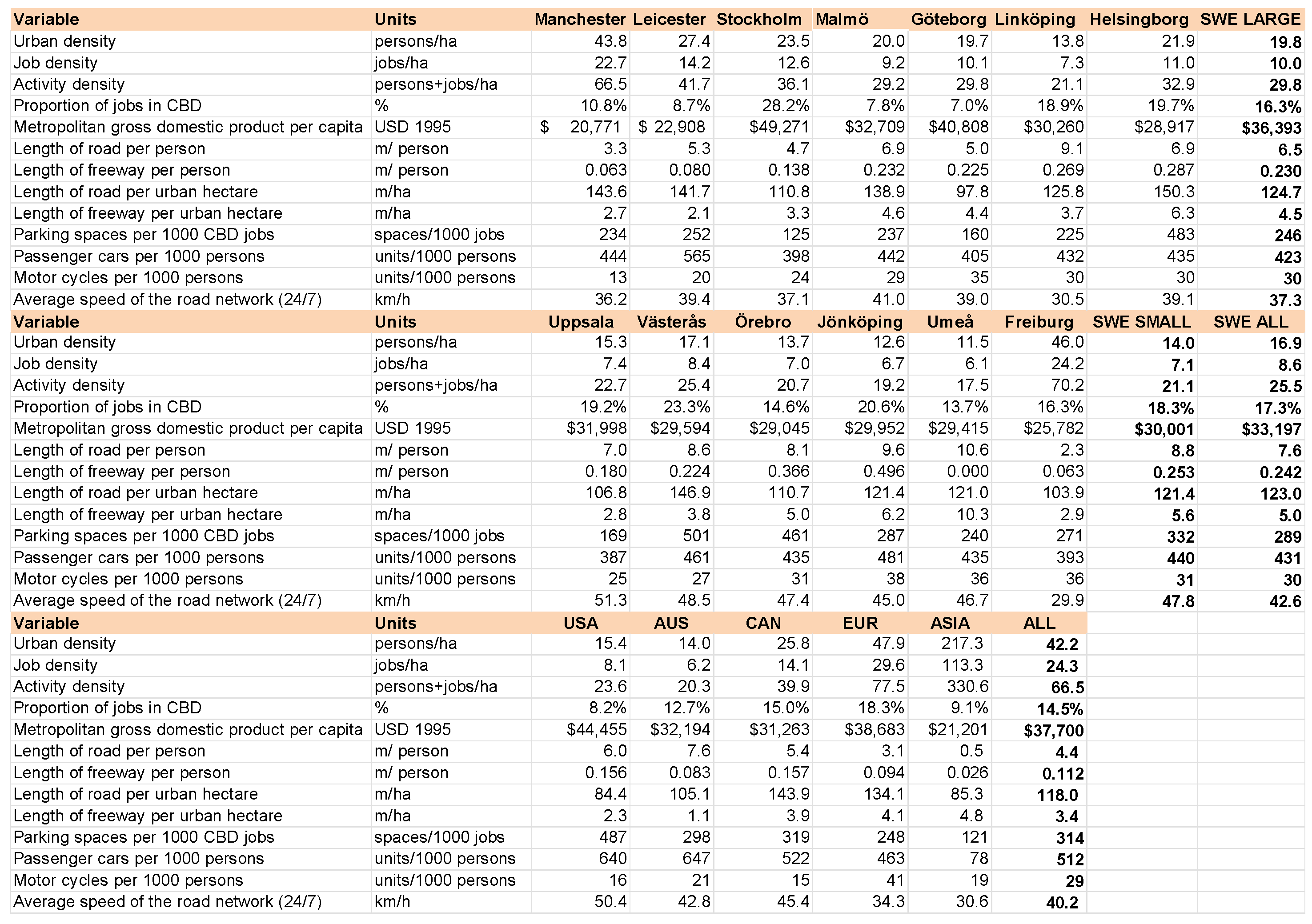
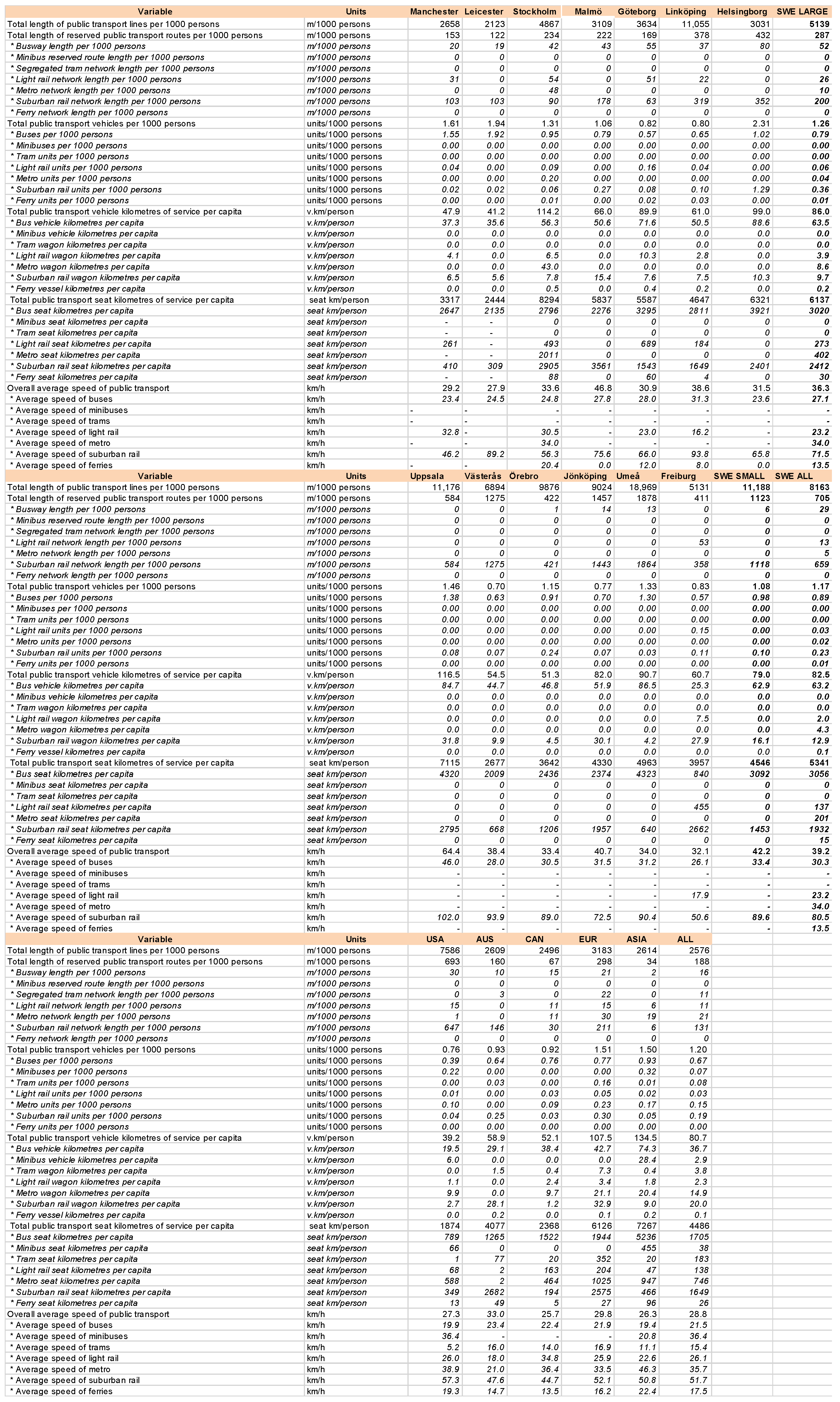



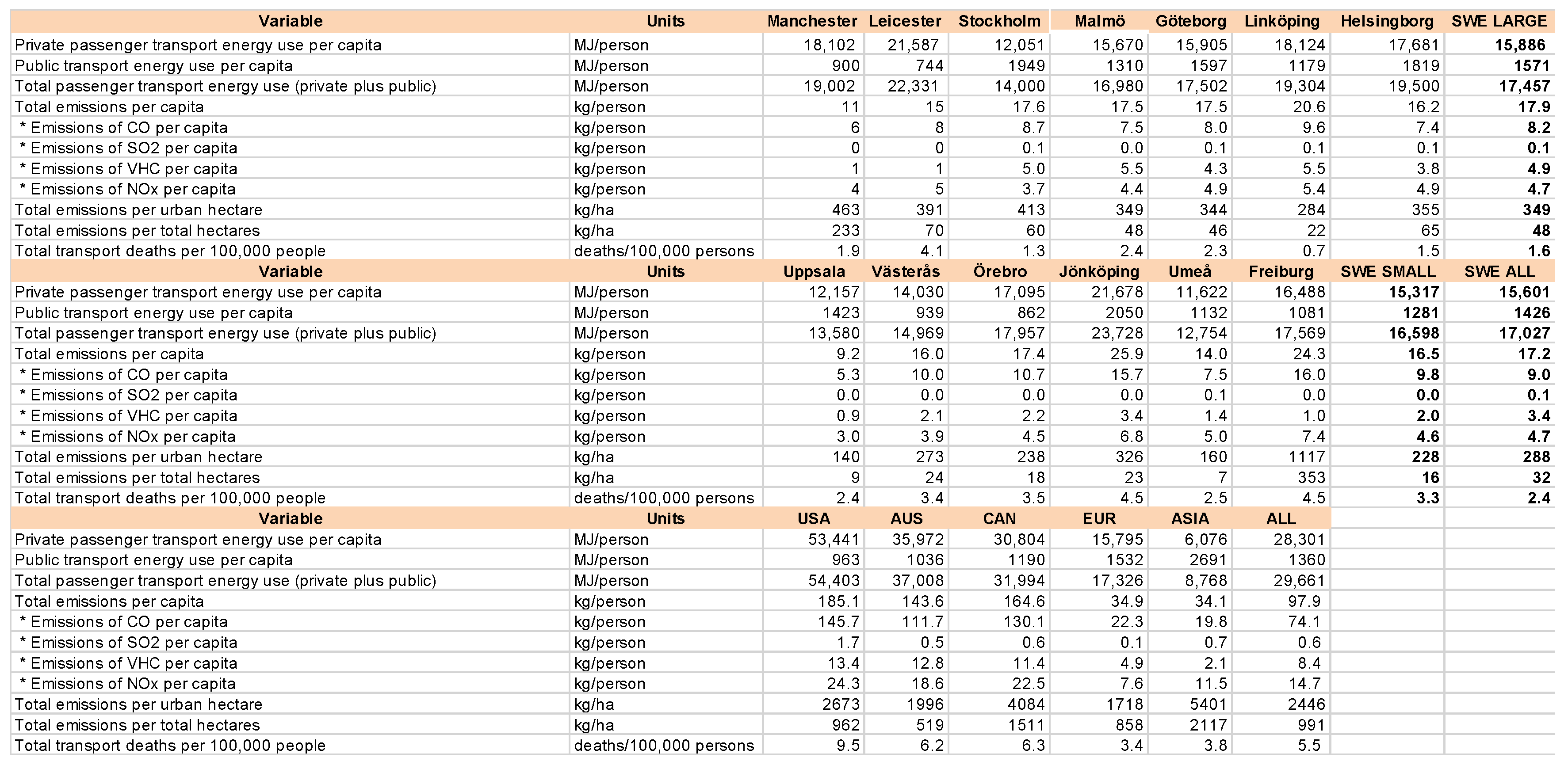

References
- Jacobs, J. The Death and Life of Great American Cities; Vintage: New York, NY, USA, 1961. [Google Scholar]
- Mumford, L. The City in History; Penguin Press: London, UK, 1961. [Google Scholar]
- Schneider, K. On the Nature of Cities: Towards Creative and Enduring Human Environments; Jossey-Bass Publishers: San Francisco, CA, USA, 1979. [Google Scholar]
- Cervero, R. The Transit Metropolis: A Global Inquiry; Island Press: Washington, DC, USA, 1998. [Google Scholar]
- Newman, P.W.G.; Kenworthy, J.R. Sustainability and Cities: Overcoming Automobile Dependence; Island Press: Washington, DC, USA, 1999; 442p. [Google Scholar]
- Newman, P.; Kenworthy, J. The End of Automobile Dependence: How Cities are Moving Away from Car-Based Planning; Island Press: Washington, DC, USA, 2015; 273p. [Google Scholar]
- United Nations. United Nations Sustainable Development Goals. Goal 11; United Nations, Department of Economic and Social Affairs: New York, NY, USA, 2024; Available online: https://sdgs.un.org/goals (accessed on 13 October 2024).
- Congress for the New Urbanism. Freeways Without Futures: The Top Highways to Boulevards Campaigns in North America; Congress for the New Urbanism: Washington, DC, USA, 2025; Available online: https://www.cnu.org/sites/default/files/FWF_2025%20FINAL.pdf (accessed on 6 June 2025).
- Schiller, P.L.; Kenworthy, J.R. An Introduction to Sustainable Transportation: Policy, Planning and Implementation; Routledge: New York, NY, USA, 2018. [Google Scholar]
- Whitelegg, J. Mobility: A New Urban Design and Transport Planning Philosophy for a Sustainable Future; Straw Barnes Press: Church Stretton, UK, 2015. [Google Scholar]
- Whitelegg, J.; Haq, G. The Earthscan Reader on World Transport Policy and Practice; Earthscan: Abingdon, UK, 2003. [Google Scholar]
- Wen, L.; Kenworthy, J.; Marinova, D. Higher Density Environments and the Critical Role of City Streets as Public Open Spaces. Sustainability 2020, 12, 8896. [Google Scholar] [CrossRef]
- Newman, P.W.G.; Kenworthy, J.R. Cities and Automobile Dependence: An International Sourcebook; Gower: Aldershot, UK, 1989; 388p. [Google Scholar]
- Kenworthy, J.R.; Laube, F.B. An International Sourcebook of Automobile Dependence in Cities, 1960-1990; University Press of Colorado: Boulder, CO, USA, 1999; 704p. [Google Scholar]
- Kenworthy, J.; Laube, F. The Millennium Cities Database for Sustainable Transport; Institute for Science and Technology Policy, Murdoch University, Perth and The International Association for Public Transport (UITP): Brussels, Belgium, 2001. [Google Scholar]
- Kenworthy, J.R. Urban Transport and Eco-Urbanism: A Global Comparative Study of Cities with a Special Focus on Five Larger Swedish Urban Regions. Urban Sci. 2019, 3, 25. [Google Scholar] [CrossRef]
- Kenworthy, J. Passenger Transport Energy Use in Ten Swedish Cities: Understanding the Differences Through a Comparative Review. Energies 2020, 13, 3719. [Google Scholar] [CrossRef]
- Kenworthy, J.R.; Svensson, H. Exploring the energy saving potential in private, public and non-motorized transport for ten Swedish cities. Sustainability 2022, 14, 954. [Google Scholar] [CrossRef]
- Federal Highway Administration. History of the Interstate Highway System. United States Department of Transportation. 2025. Available online: https://highways.dot.gov/highway-history/interstate-system/50th-anniversary/history-interstate-highway-system (accessed on 11 May 2025).
- Klein, J.; Olson, M. Taken for a Ride, New Day Films. 1996. Available online: https://www.newday.com/films/taken-for-a-ride (accessed on 19 August 2025).
- Newman, P.; Kosonen, L.; Kenworthy, J. Theory of urban fabrics: Planning the walking, transit/public transport and automobile/motor car cities for reduced car dependency. Town Plan. Rev. 2016, 87, 429–458. [Google Scholar]
- Teplanova, K. Benchmarking Methodology. South East Europe Transnational Cooperation Programme. Project Title SEE Science, Project Number SEE/B/0048/1.3/X. 2012. Available online: https://www.cvtisr.sk/buxus/docs/SEE_Science/Benchmarking_methodology.pdf (accessed on 25 May 2025).
- Newman, P.W.G.; Kenworthy, J.R. Gasoline consumption and cities: A comparison of US cities with a global survey and its implications. J. Am. Plan. Assoc. 1989, 55, 24–37. [Google Scholar]
- Kenworthy, J.; Laube, F.B.; Newman, P.W.G.; Barter, P.A. Indicators of Transport Efficiency in 37 Global Cities; A Report for the World Bank, ISTP; Murdoch University: Perth, Australia, 1997. [Google Scholar]
- Newman, P.; Kenworthy, J. Public and private transport in Australian cities: I. An analysis of existing patterns and their energy implications. Transp. Policy Decis. Mak. 1980, 1, 133–148. [Google Scholar]
- Newman, P.; Kenworthy, J. Public and private transport in Australian cities: II. The potential for energy conservation through land use change. Transp. Policy Decis. Mak. 1980, 1, 149–167. [Google Scholar]
- Newman, P.W.G.; Kenworthy, J.R. Towards a More Sustainable Canberra: An Assessment of Canberra’s Transport, Energy and Land Use; Institute for Science and Technology Policy, Murdoch University: Perth, Australia, 1991; 157p. [Google Scholar]
- Poboon, C. Anatomy of a Traffic Disaster: Towards a Sustainable Solution to Bangkok’s Transport Problems. Ph.D. Dissertation, Murdoch University, Perth, Australia, 1998. [Google Scholar]
- Barter, P. An International Comparative Perspective on Urban Transport and Urban Form in Pacific Asia: Responses to The Challenge of Motorisation in Dense Cities. Ph.D. Dissertation, Murdoch University, Perth, Australia, 1999. [Google Scholar]
- Laube, F.B. Optimising Urban Passenger Transport: Developing a Least-Cost Model Based on International Comparisons of Urban Transport Costs, Transport Patterns, Land Use, Infrastructure, Environment and Best Practice in Public Transport. Ph.D. Dissertation, Murdoch University, Perth, Australia, 1998. [Google Scholar]
- Kenworthy, J.R. Is Automobile Dependence in Emerging Cities an Irresistible Force? Perspectives from São Paulo, Taipei, Prague, Mumbai, Shanghai, Beijing and Guangzhou. Sustainability 2017, 9, 1953. [Google Scholar] [CrossRef]
- Gudmundsson, H.; Wyatt, A.; Gordon, L. Benchmarking and Sustainable Transport Policy: Learning from the BEST Network. Transport Reviews. Transp. Energy Use Sustain. 2005, 25, 669–690. [Google Scholar] [CrossRef]
- de Freitas Miranda, H.; da Silva Rodrigues, A.N. Benchmarking sustainable urban mobility: The case of Curitiba, Brazil. Transp. Policy 2012, 21, 141–151. [Google Scholar] [CrossRef]
- da Silva, A.N.R.; de Azevedo Filho, M.A.N.; Macêdo, M.H.; Sorratini, J.A.; da Silva, A.F.; Lima, J.P.; Pinheiro, A.M.G.S. A comparative evaluation of mobility conditions in selected cities of the five Brazilian regions. Transp. Policy 2015, 37, 147–156. [Google Scholar] [CrossRef]
- Matsunaka, R.; Oba, T.; Nakagawa, D.; Nagao, M.; Nawrocki, J. International comparison of the relationship between urban structure and the service level on urban public transportation: A comprehensive analysis of local cities in Japan, France and Germany. Transp. Policy 2013, 30, 26–39. [Google Scholar] [CrossRef]
- De Gruyter, C.; Currie, G.; Rose, G. Sustainability measures of urban public transport in cities: A world review and focus on the Asia/Middle East Region. Sustainability 2017, 9, 43. [Google Scholar] [CrossRef]
- Hajduk, S. Assessment of urban transport: A comparative analysis of selected cities by taxonomic methods. Econ. Manag. 2016, 8, 67–74. [Google Scholar] [CrossRef][Green Version]
- Stone, J.; Mees, P.; Imran, M. Benchmarking the efficiency and effectiveness of public transport in New Zealand cities. Urban Policy Res. 2011, 30, 207–224. [Google Scholar] [CrossRef]
- Zito, P.; Salvo, G. Towards an urban transport sustainability index: An European Comparison. Eur. Transp. Res. Rev. 2011, 3, 179–195. [Google Scholar] [CrossRef]
- Alonso, A.; Monzón, A.; Cascajo, R. Comparative analysis of passenger transport sustainability in European cities. Ecol. Indic. 2015, 48, 578–592. [Google Scholar] [CrossRef]
- Bratzel, S. Conditions of success in sustainable urban transport policy success: Policy change in “relatively successful European cities. Transp. Rev. 1999, 19, 177–190. [Google Scholar] [CrossRef]
- Lowe, M.; Adlakha, D.; Sallis, J.F.; Salvo, D.; Cerin, E.; Moudon, A.V.; Higgs, C.; Hinckson, E.; Arundel, J.; Boeing, G.; et al. City planning policies to support health and sustainability: An international comparison of policy indicators for 25 cities. Lancet Glob. Health 2022, 10, E882–E992. [Google Scholar] [CrossRef]
- Li, W.; Bao, L.; Li, Y.; Si, H.; Li, Y. Assessing the transition to low-carbo urban transport: A global comparison. Resour. Conserv. Recycl. 2022, 180, 106179. [Google Scholar] [CrossRef]
- Tamaki, T.; Nakamura, H.; Fujii, H.; Managi, S. Efficiency and emissions from urban transport: Application to world city-level public transportation. Econ. Anal. Policy 2019, 61, 55–63. [Google Scholar] [CrossRef]
- Gordon, P.; Richardson, H. Gasoline Consumption and Cities: A Reply. J. Am. Plan. Assoc. 1989, 55, 342–346. [Google Scholar] [CrossRef]
- Newman, P.W.G.; Kenworthy, J.R. Is there a role for physical planning? J. Am. Plan. Assoc. 1992, 48, 353–362. [Google Scholar] [CrossRef]
- McIntosh, J.; Trubka, R.; Kenworthy, J.; Newman, P. The role of urban form and transit in city car dependence: Analysis of 26 global cities from 1960–2000. Transp. Res. Part D Transp. Environ. 2014, 33, 95–110. [Google Scholar] [CrossRef]
- Lewis, S.; Grande del Valle, E. San Francisco’s neighborhoods and auto dependency. Cities 2019, 86, 11–24. [Google Scholar] [CrossRef]
- Cervero, R. Sustainable new towns: Stockholm’s rail served satellites. Cities 1995, 12, 41–51. [Google Scholar] [CrossRef]
- Goldberg, M.; Mercer, J. The Myth of the North American City: Continentalism Challenged; UBC Press: Vancouver, BC, Canada, 1986. [Google Scholar]
- Cervero, R. Urban Transit in Canada: Innovation and Integration at its Best. Transp. Q. 1986, 40, 293–316. [Google Scholar]
- Thomson, J.M. Great Cities and Their Traffic; Penguin Books: Middlesex, UK, 1977. [Google Scholar]
- Kenworthy, J. Urban Structure and its Impact on Mobility Patterns: Reducing Automobile Dependence through Polycentrism. In The Palgrave Encyclopedia of Urban and Regional Futures; Brears, R., Ed.; Springer Nature: Cham, Switzerland, 2021. [Google Scholar] [CrossRef]
- Watt, K.E.F.; Ayres, C. Urban land use patterns and transportation energy cost. In Proceedings of the 140th Annual Meeting of the American Association for the Advancement of Science (AAAS), San Francisco, CA, USA, 25 February 1974. [Google Scholar]
- Perl, A.; Hern, M.; Kenworthy, J. Big Moves: Global Agendas, Local Aspirations and Urban Mobility in Canada. Studies in Urban Governance Series; McGill-Queen’s University Press: Montreal, QC, Canada, 2020. [Google Scholar]
- Shoup, D. The High Cost of Free Parking; Routledge: New York, NY, USA, 2011. [Google Scholar]
- Shoup, D. Parking and the City; Routledge: New York, NY, USA, 2018. [Google Scholar]
- Newman, P.; Kenworthy, J. ‘Relative speed’ not ‘time savings’: A new indicator for sustainable transport. In Proceedings of the 23rd Australasian Transport Research Forum, Perth, Australia, 29 September–1 October 1999; pp. 425–440. [Google Scholar]
- Litman, T. Evaluating rail transit benefits: A comment. Transp. Policy 2007, 14, 94–97. [Google Scholar] [CrossRef]
- Kenworthy, J. An international review of the significance of rail in developing more sustainable urban transport systems in higher income cities. World Transp. Policy Pract. 2008, 14, 21–37. [Google Scholar]
- Hass-Klau, C.; Crampton, G. Future of Urban Transport Learning from Success and Weakness: Light Rail; Environmental and Transport Planning: Brighton, UK, 2002. [Google Scholar]
- Hass-Klau, C.; Crampton, G.; Benjari, R. Economic Impact of Light Rail: The Results of 15 Urban Areas in France, Germany, UK and North America; Environmental and Transport Planning: Brighton, UK, 2004. [Google Scholar]
- Hass-Klau, C.; Crampton, G.; Biereth, C.; Deutsch, V. Bus or Light Rail: Making the Right Choice—A Financial, Operational and Demand Comparison of Light Rail, Guided Buses, Busways and Bus Lanes; Environmental and Transport Planning: Brighton, UK, 2003. [Google Scholar]
- Kenworthy, J.R. Chapter 3: The good, the bad and the ugly in urban transport: Comparing global cities for dependence on the automobile. In Methods for Sustainability Research; Hartz-Karp, J., Marinova, D., Eds.; Edward Elgar Publishing: Cheltenham, UK, 2017; pp. 46–62. [Google Scholar]
- Kenworthy, J. Chapter 5: Trends in Transport and Urban Development in Thirty-Three International Cities, 1995-6 to 2005-6: Some Prospects for Lower Carbon Transport. In Low Carbon Cities: Transforming Urban Systems; Lehmann, S., Ed.; Routledge: London, UK, 2014; pp. 113–130. [Google Scholar]
- Jauregui-Fung, F.; Kenworthy, J.; Almaaroufi, S.; Pulido-Castro, N.; Pereira, S.; Golda-Pongratz, K. Anatomy of an Informal Transit City: Mobility Analysis of the Metropolitan Area of Lima. Urban Sci. 2019, 3, 67. [Google Scholar] [CrossRef]
- Linares-Rendon, F.; Garrido-Cumbrera, M. Impact of the COVID-19 Pandemic on Urban Mobility: A Systematic Review of the Existing Literature. J. Transp. Health 2021, 22, 101225. [Google Scholar] [CrossRef]
- Australian Bureau of Statistics. Survey of Motor Vehicle Use, Australia; Australian Bureau of Statistics: Canberra, Australia, 2020. Available online: https://www.abs.gov.au/statistics/industry/tourism-and-transport/survey-motor-vehicle-use-australia/latest-release (accessed on 19 August 2025).
- Macrotrends. 2025. Available online: www.macrotrends.net/global-metrics/cities/22862/manchester/population (accessed on 11 May 2025).
- World Population Review. Leicester Population 2025. Available online: https://worldpopulationreview.com/cities/united-kingdom/leicester (accessed on 5 September 2025).
- Varbes. Population of Leicestershire. 2025. Available online: https://www.varbes.com/population/leicestershire-population (accessed on 19 August 2025).
- JHamez84. Map of Greater Manchester. 2025. Available online: https://commons.wikimedia.org/wiki/File:Greater_Manchester_County.svg (accessed on 5 September 2025).
- Nilfanion. Greater Manchester Locator Map. 2025. Available online: https://commons.wikimedia.org/wiki/File:Greater_Manchester_UK_locator_map_2010.svg (accessed on 5 September 2025).
- Nilfanion. Map of the Leicester Metropolitan Area and its Location in the UK (The Large City of Leicester is Situated in the Middle). Ordnance Survey OpenData. 2025. Available online: https://commons.wikimedia.org/wiki/File:Leicestershire_UK_parish_map_(blank).svg (accessed on 5 September 2025).
- Hilton, N.J. 2025. Available online: https://www.pexels.com/photo/urban-tram-at-salford-quays-station-during-sunset-30675768/ (accessed on 4 June 2025).
- Dixon, D. Integration Between Suburban Rail and Light Rail in Manchester. 2025. Available online: https://commons.wikimedia.org/wiki/File:Manchester_Victoria_Station_Tram_Platforms_(December_2015)_-_geograph.org.uk_-_4763752.jpg (accessed on 5 September 2025).
- Anonymous. Buses in Oxford Road, Manchester (Creative Commons 4.0 International License). 2025. Available online: https://commons.wikimedia.org/wiki/File:Manchester_Oxford_Road_buses_(1).jpg (accessed on 5 September 2025).
- Law, J. Leicester Bus. Leics—Thurmaston Bus b870dom Leicester 26-7-11 JL|Flickr. 2025. Available online: https://www.flickr.com/photos/johnmightycat/5984885004/in/photolist-5F7T4t-5FcjLw-5Fc6RJ-5Fcq8A-5Fc9Rw-acNTaM-a7S6Nu-5F81je-eCNmQ2-wq5t8Y-D8WeXP-8QPipB-npqzEc-acNTfg-7ussou-9K4GXq-ag5v7s-dhUSJE-HXwsLa-95SCoe-aMmq2n-Ky3LjS-aMmpiV-JQVX3w-bAU51c-D1Ek8D-acRGKE-acNSTX-Jt2VAN-95SCri-Jt48Pd-bdgGDR-FB1ZqJ-G7nkYQ-d7TVXA-d7U1ML-K3QuKM-a7VApC-bnZeYL-dDjwbu-JLWcqD-95VEtj-9DDqEP-d7TW69-a7VApJ-D6C2wq-ag2KuR-aMmon2-95SCk2-9K1SrZ (accessed on 5 September 2025).
- Kris1973. Leicester’s Haymarket Bus Station. 2025. Available online: https://commons.wikimedia.org/wiki/File:Dworzec_autobusowy_Haymarket.jpg (accessed on 5 September 2025).
- Joieman. Rear of Haymarket Bus Station, Leicester. 2025. Available online: https://commons.wikimedia.org/wiki/File:Haymarket_Bus_Station,_Leicester.jpg (accessed on 5 September 2025).
- Eveby, S.; Håkansson, M. Vision Zero: Revisiting What Sweden Means By Vision Zero and How Do We Get There? World Transp. Policy Pract. 2024, 29, 13–25. [Google Scholar]
- Newman, P.W.G.; Kenworthy, J.R. The transport energy trade-off: Fuel-efficient traffic versus fuel-efficient cities. Transp. Res. Part A Gen. 1988, 22, 163–174. [Google Scholar] [CrossRef]
- Punter, J. The Vancouver Achievement: Urban Planning and Design; UBC Press: Vancouver, BC, Canada, 2003. [Google Scholar]
- Whitelegg, J. (Emeritus Professor, Lancaster University, Lancaster, Lancashire, UK). Personal communication, 2023.
- Goodwin, P. Solving Congestion (When We Must Not Build Roads, Increase Spending, Lose Votes, Damage the Economy, Harm the Environment and will Never Find Equilibrium): Inaugural Lecture for the Professorship of Transport Policy [Online]. London University College. 1997. Available online: http://discovery.ucl.ac.uk/1244/1/2004_22.pdf (accessed on 22 July 2025).
- Fettig, T. Seoul: The Stream of Consciousness. e2—Series Documentary, Transport, Episode 4; Public Broadcasting Service: Arlington, VA, USA, 2008. [Google Scholar]
- Glotz-Richter, M. (Consultant for Sustainable Mobility, Bremen, Germany). Personal communication, 2012.
- Topham, G. Why has HS2 ended up being so expensive. The Guardian, 25 September 2023. [Google Scholar]
- Topham, G. Greater Manchester jumps onboard the franchise route to better buses. The Guardian, 16 September 2023. [Google Scholar]
- Topham, G. Manchester to launch ‘revolutionary’ Bee Network public bus system. The Guardian, 23 September 2023. [Google Scholar]
- Hullian OneEleven. Bee Network Bus Operating in Manchester Under Public Control. 2025. Available online: https://commons.wikimedia.org/wiki/File:Stagecoach_Manchester_80096_-_SK74_BHU.jpg (accessed on 5 September 2025).
- Buehler, R.; Pucher, J.; Dümmler, O. Verkehrsverbund: The evolution and spread of fully integrated regional public transport in Germany, Austria, and Switzerland. Int. J. Sustain. Transp. 2018, 13, 36–50. [Google Scholar] [CrossRef]
- Buehler, R.; Pucher, J.; Gerikee, R.; Götschi, T. Reducing car dependence in the heart of Europe: Lessons from Germany, Austria, and Switzerland. Transp. Rev. 2016, 37, 4–28. [Google Scholar] [CrossRef]
- Neff, J.W. Substitution rates between transit and car travel. In Proceedings of the Annual Meeting of the Association of American Geographers (AAG), Charlotte, NC, USA, 9–13 April 1996. [Google Scholar]

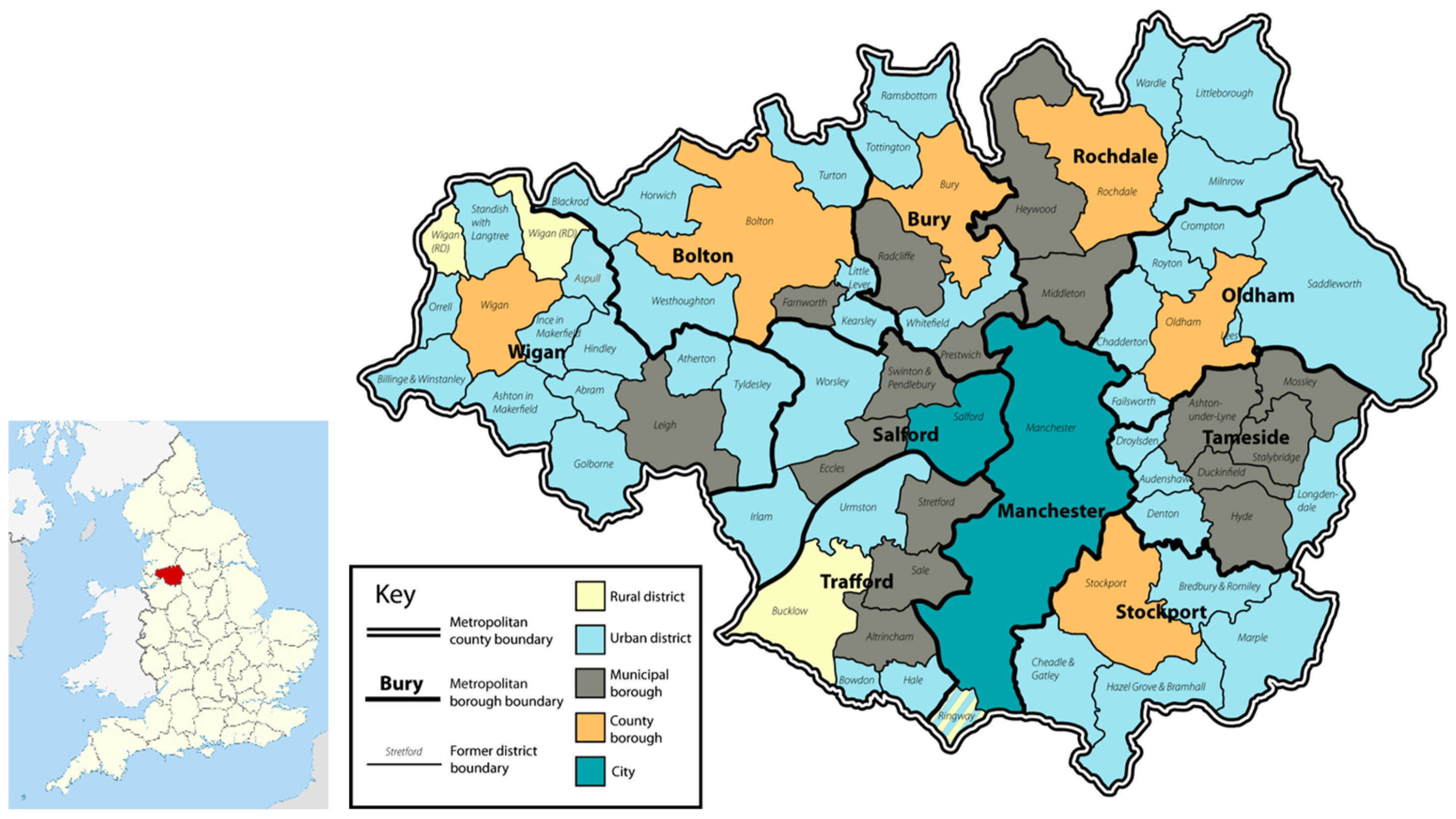
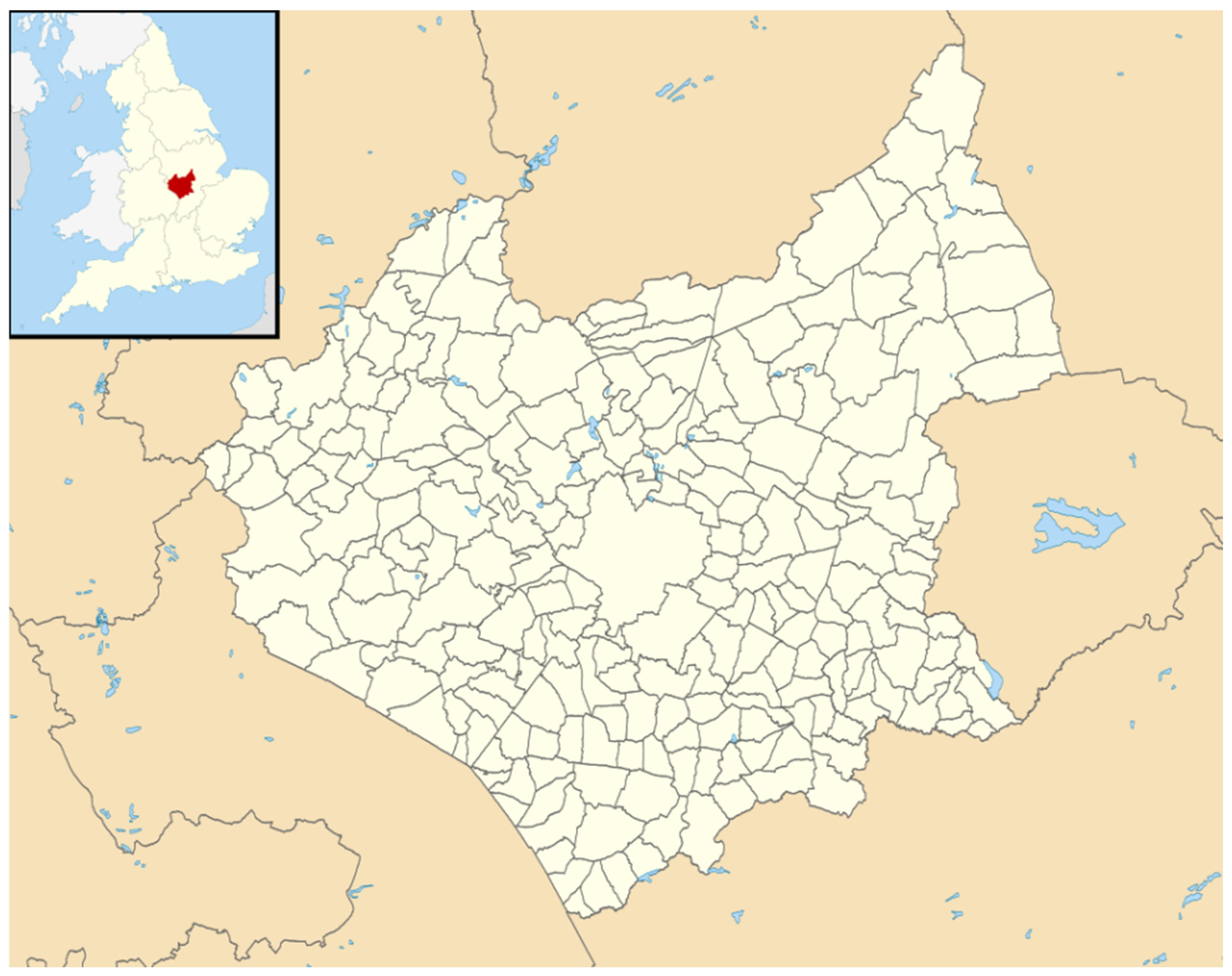
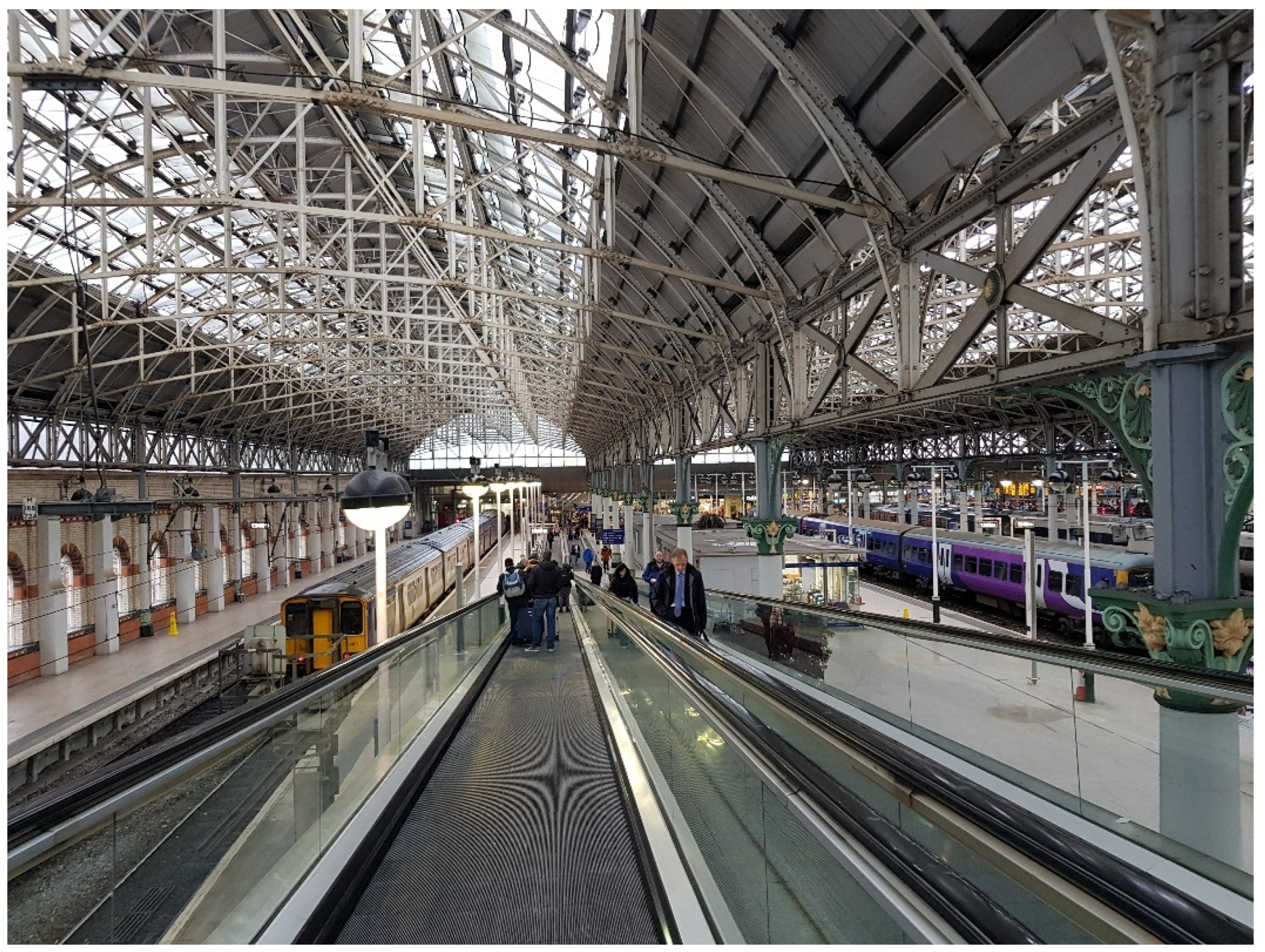
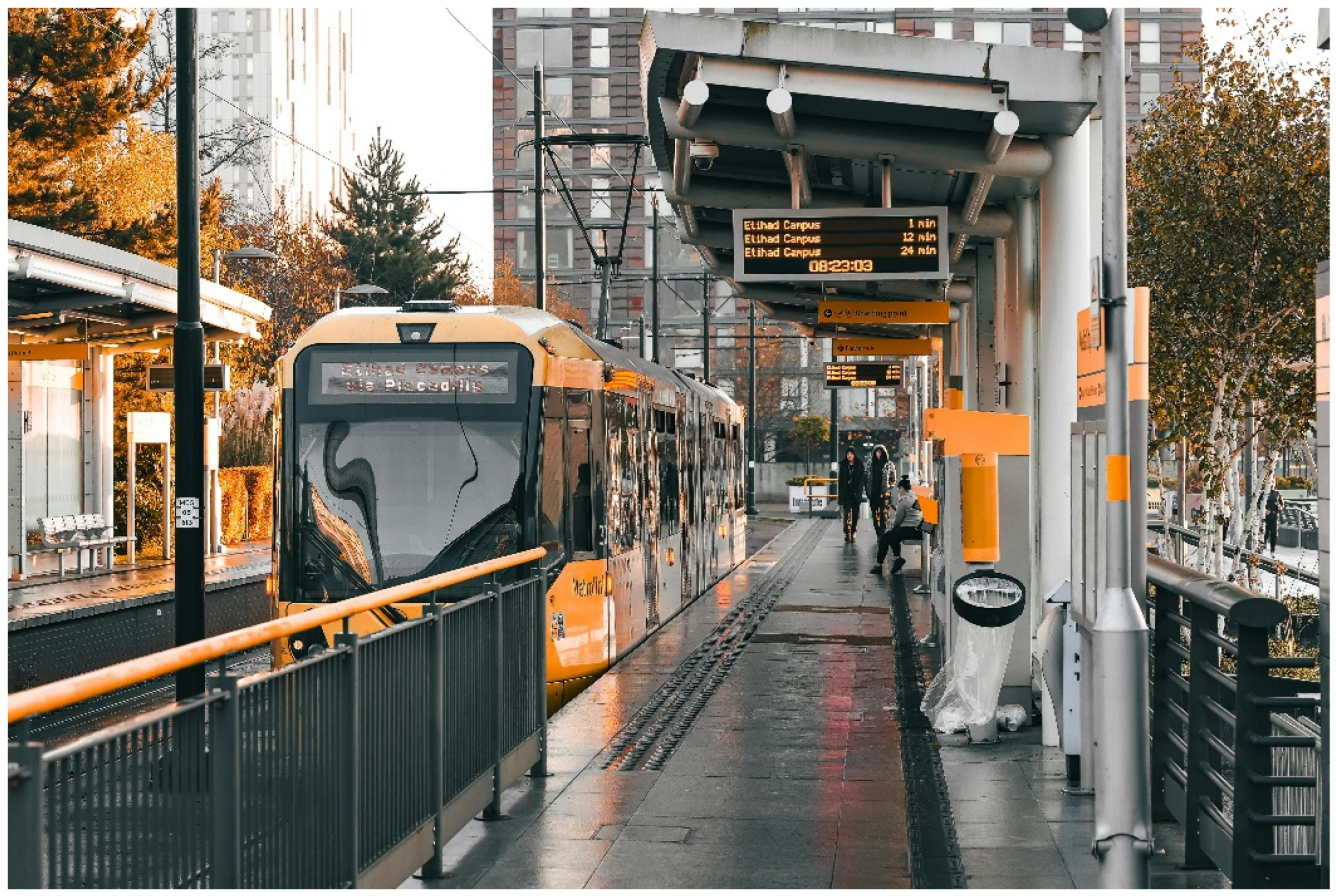
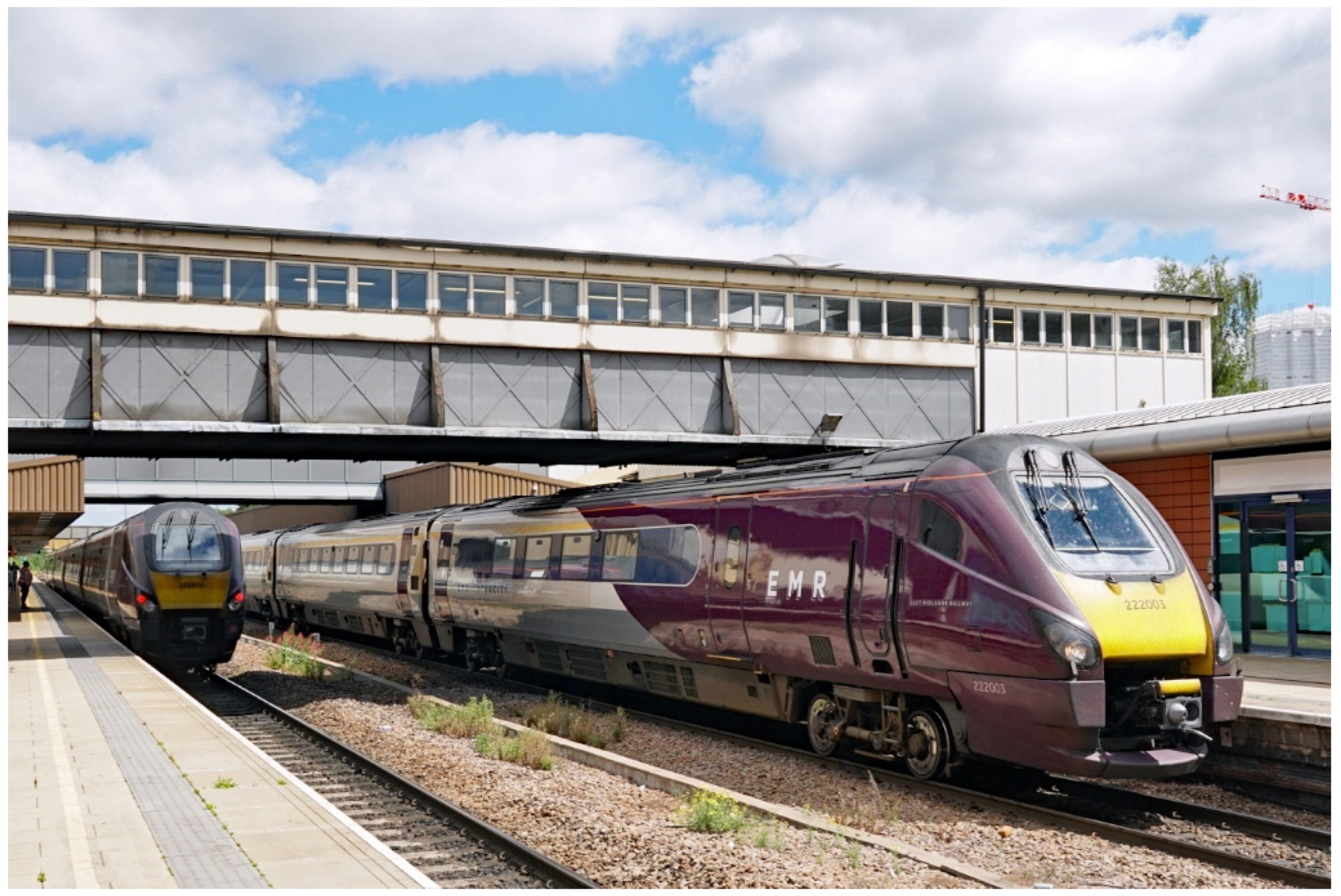
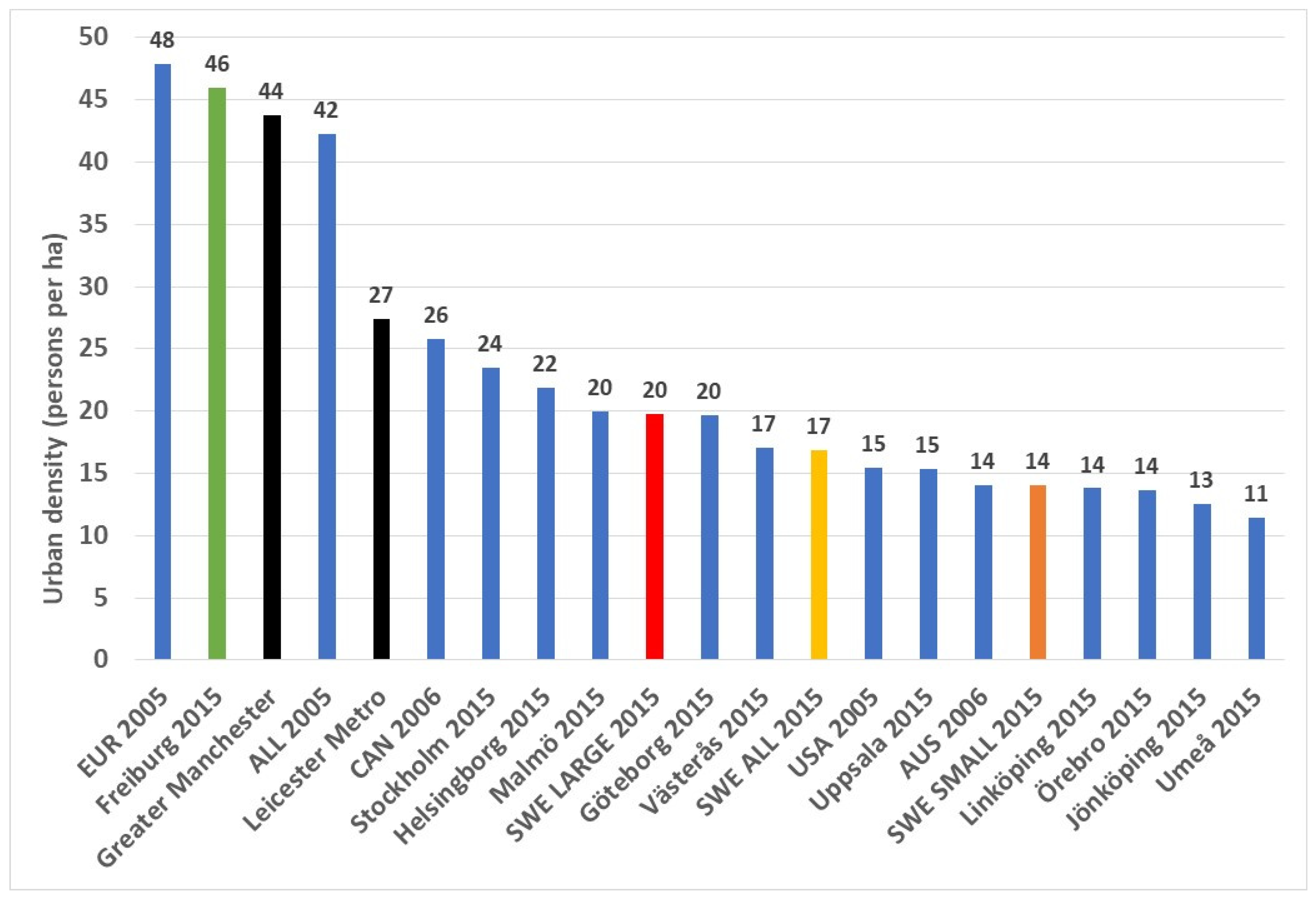

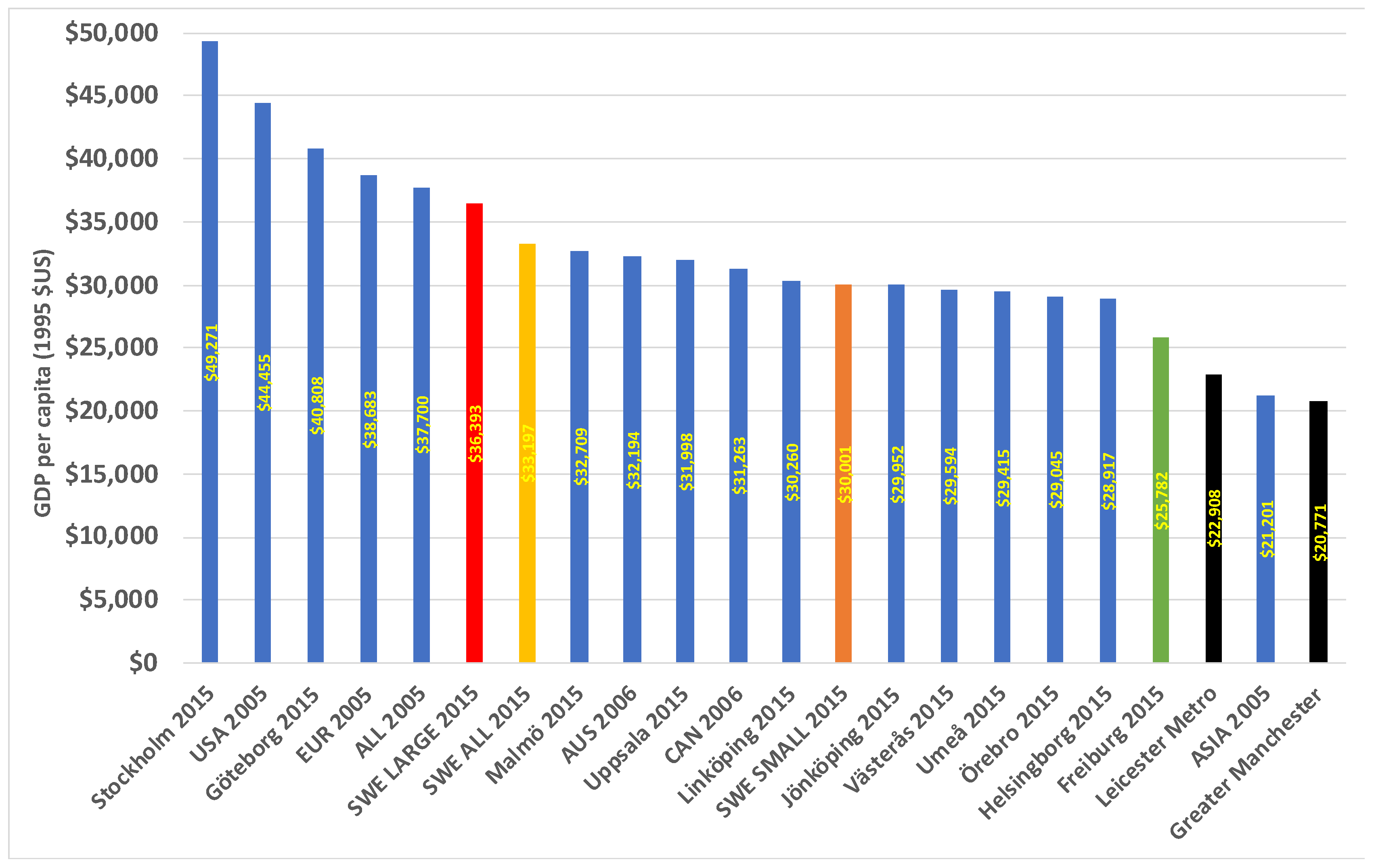
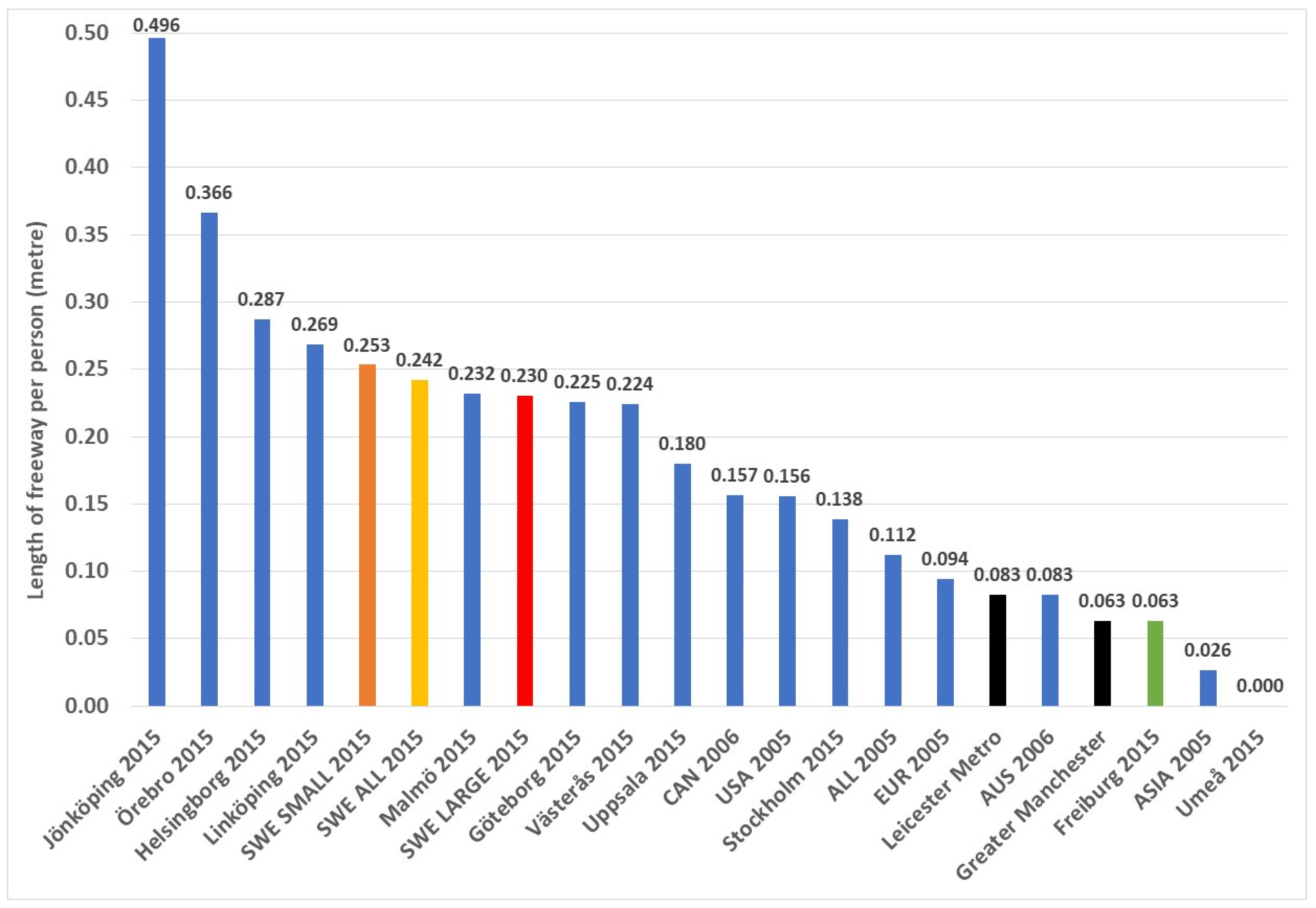


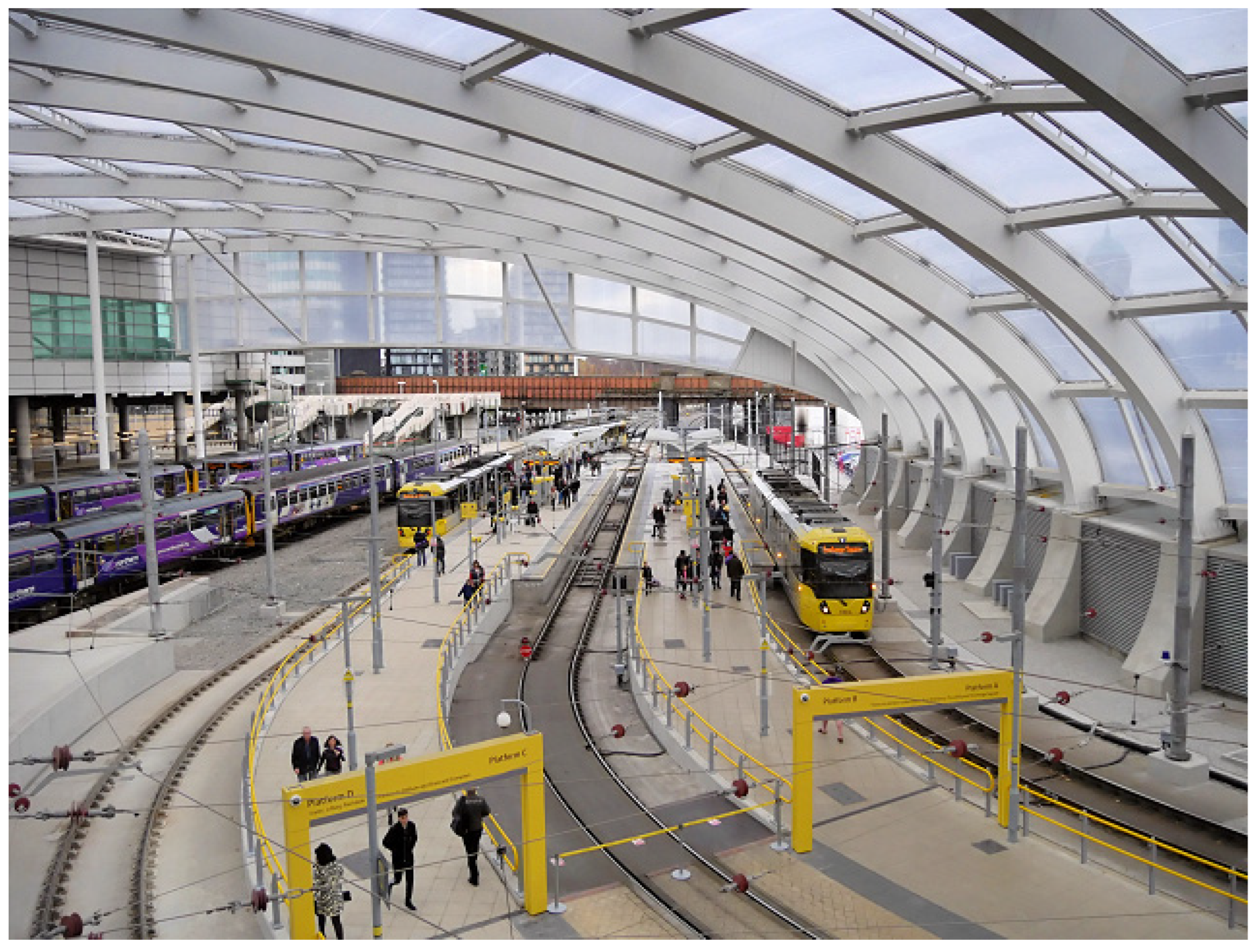
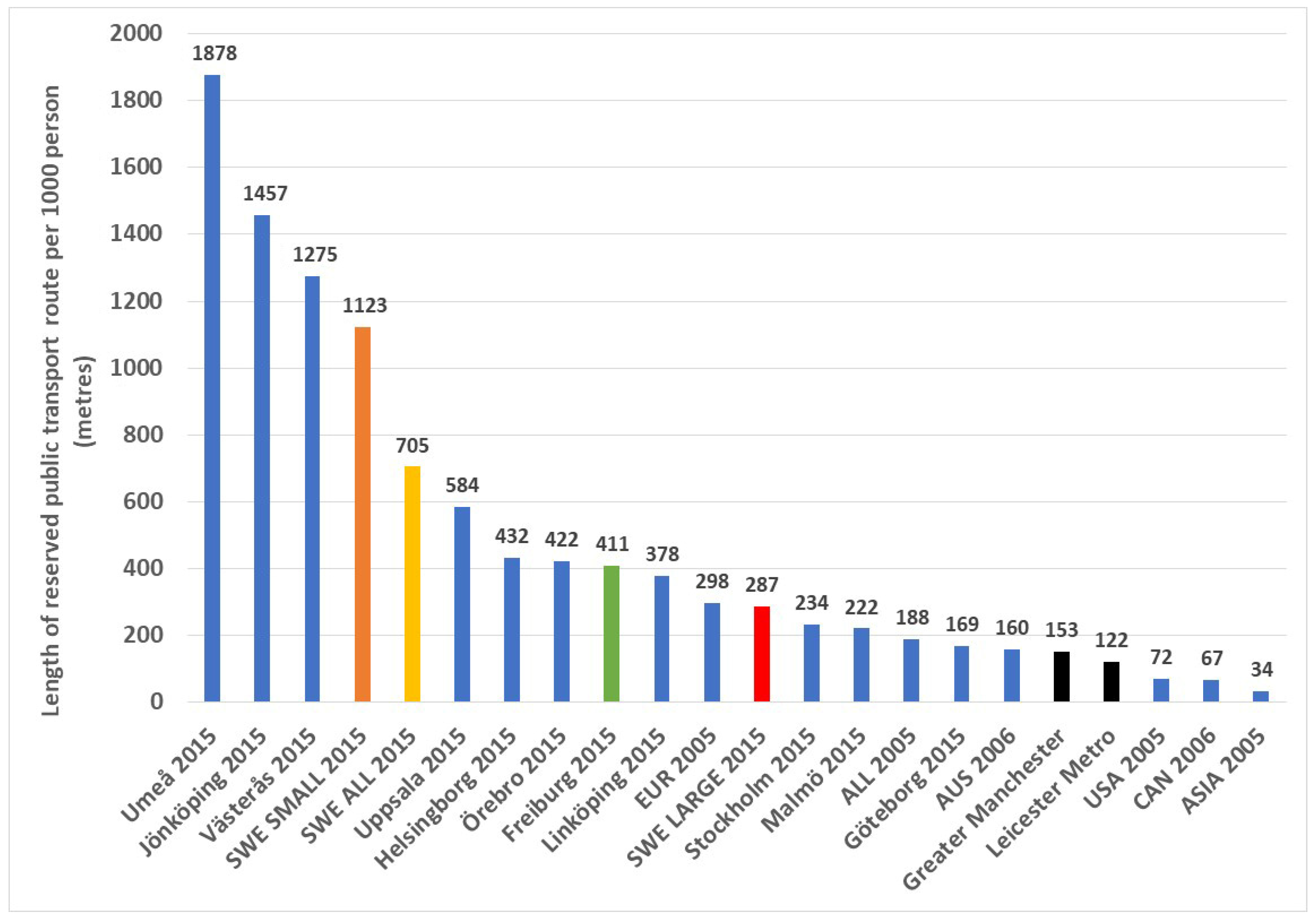
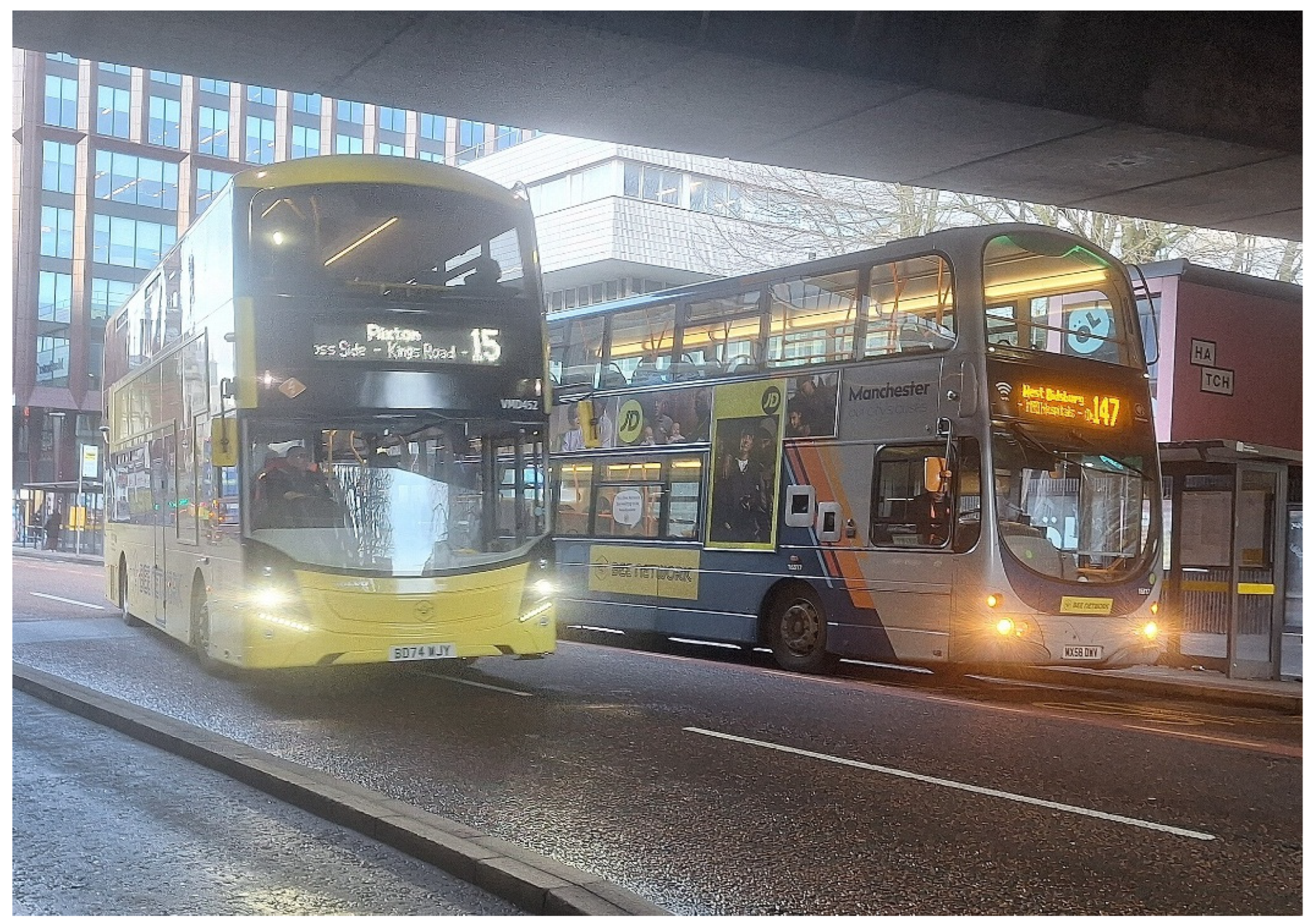
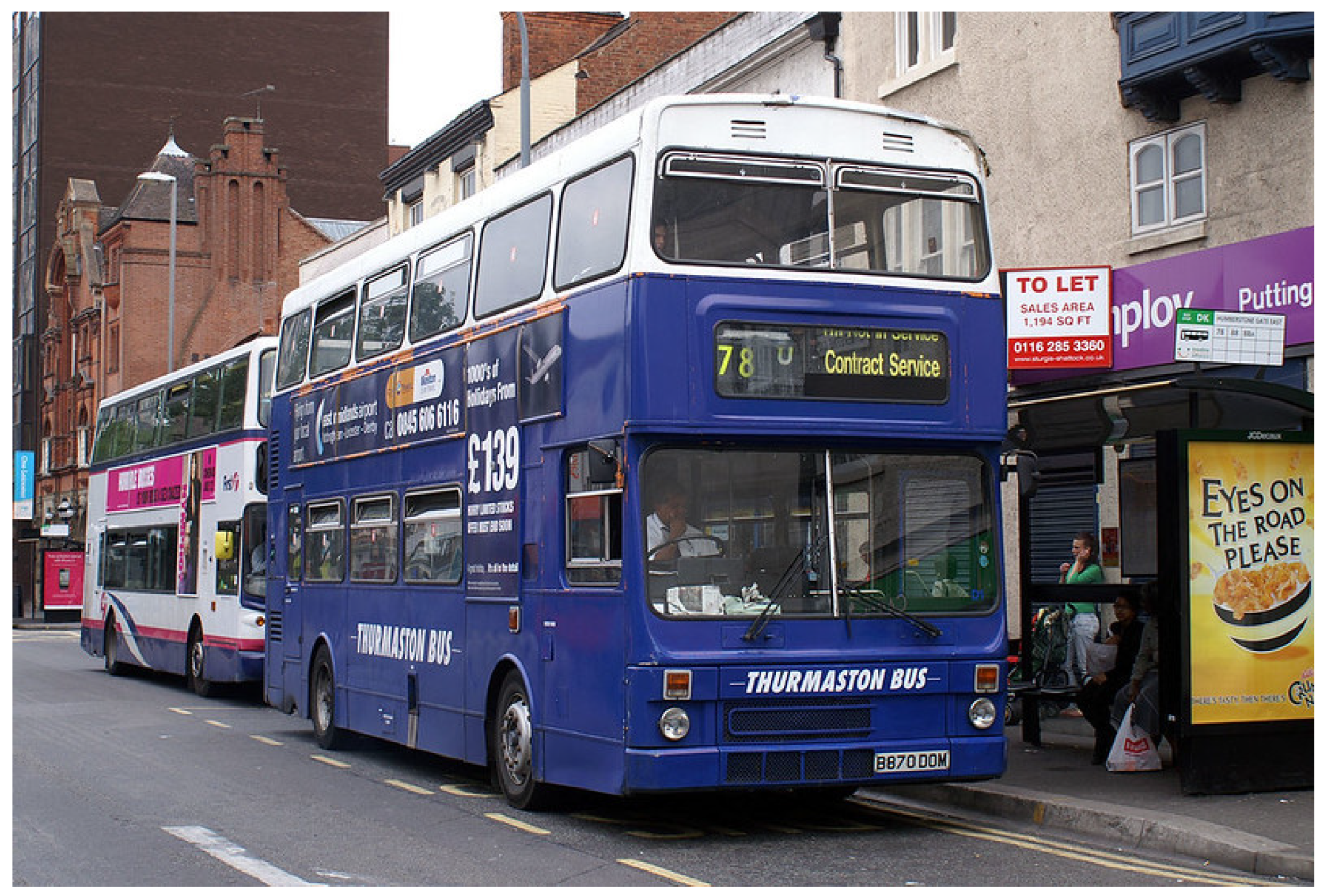
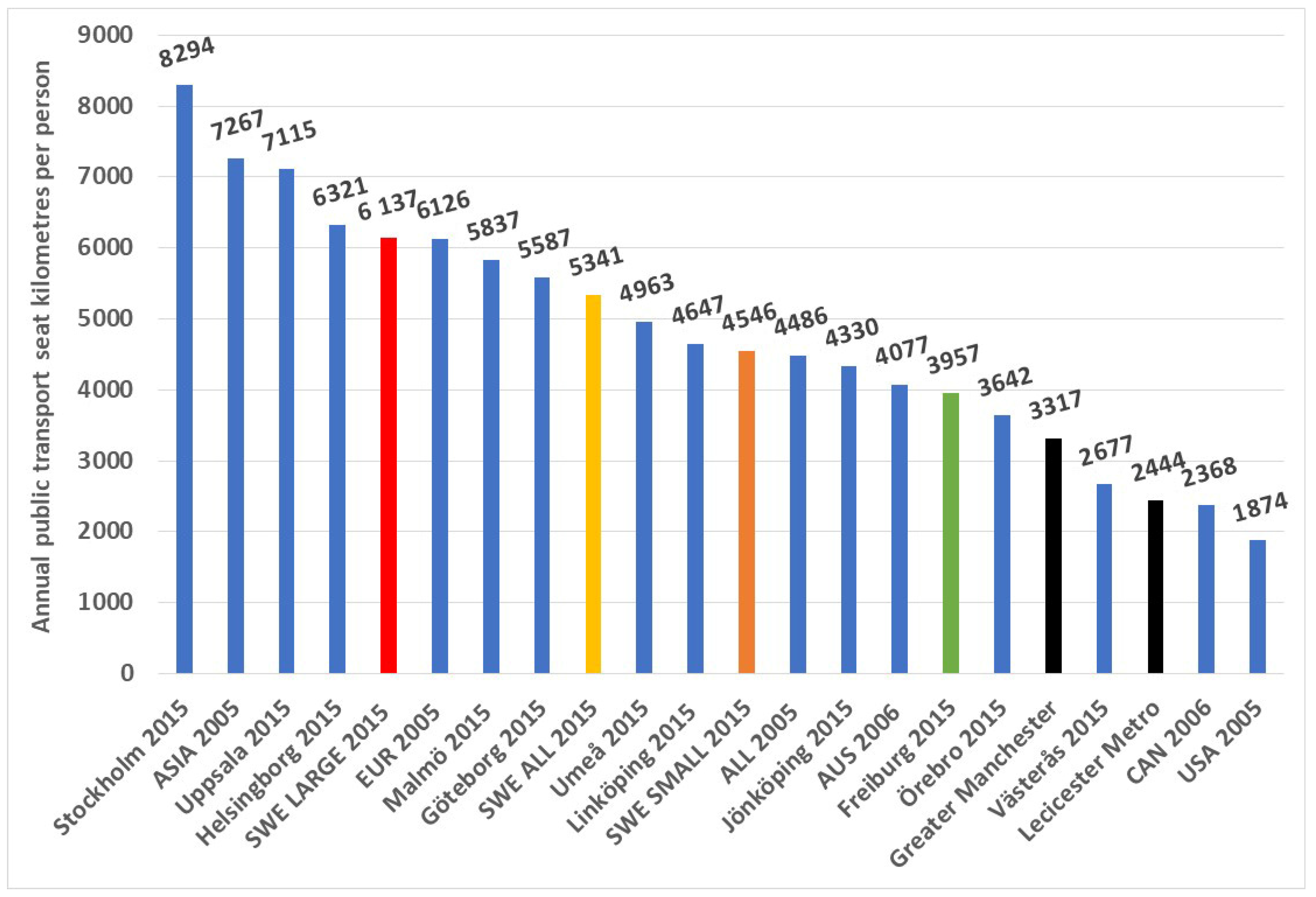
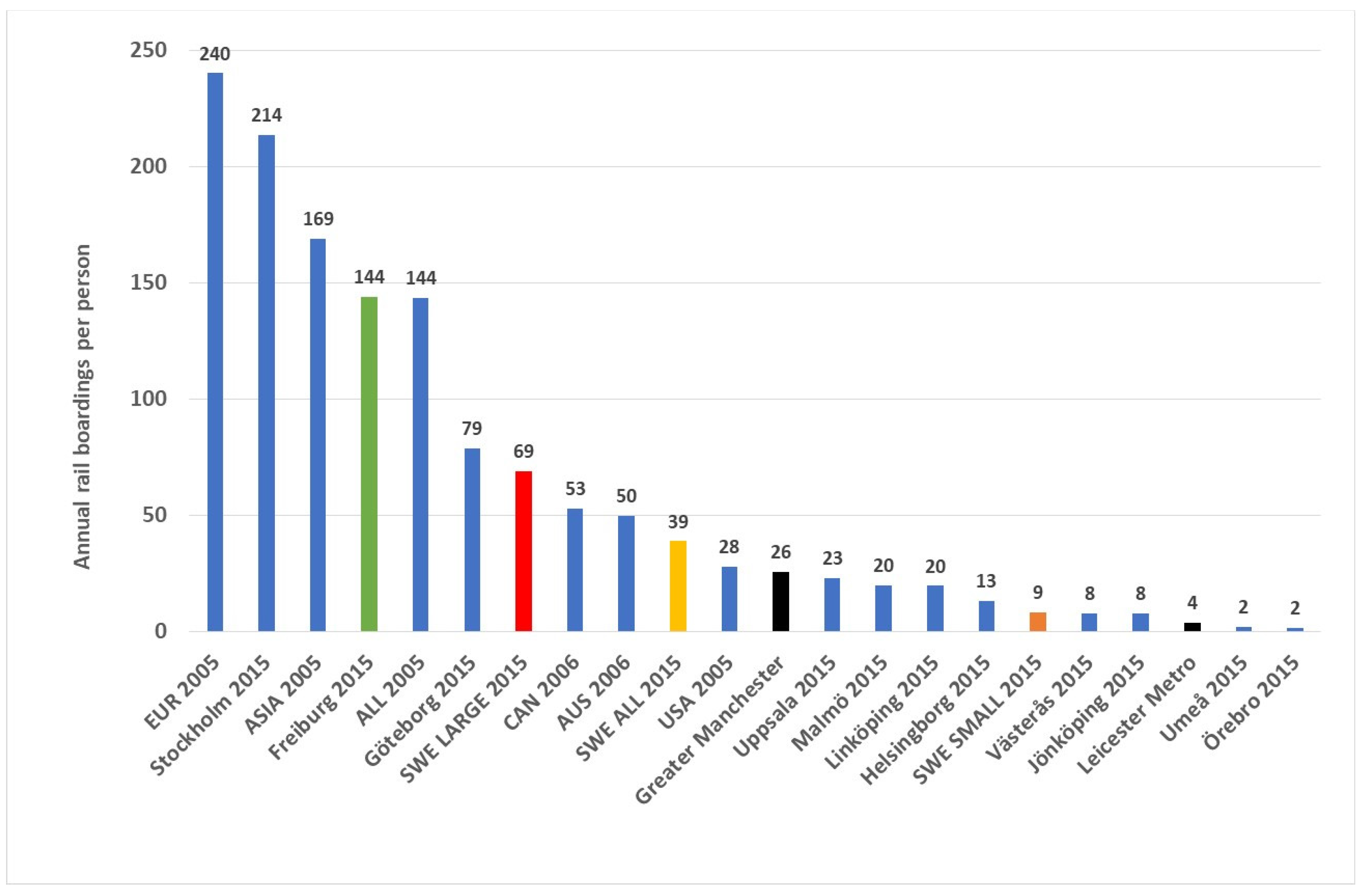
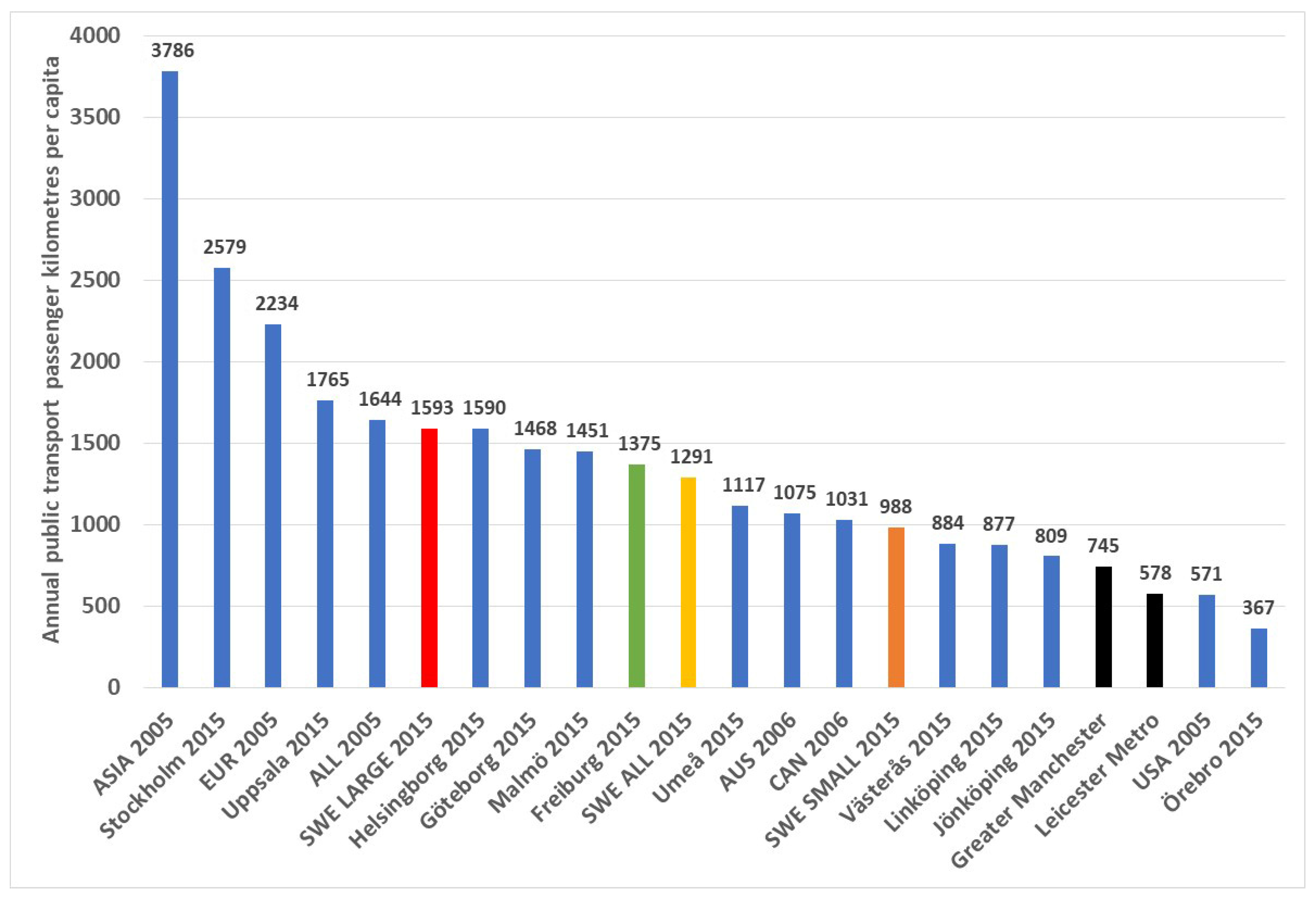
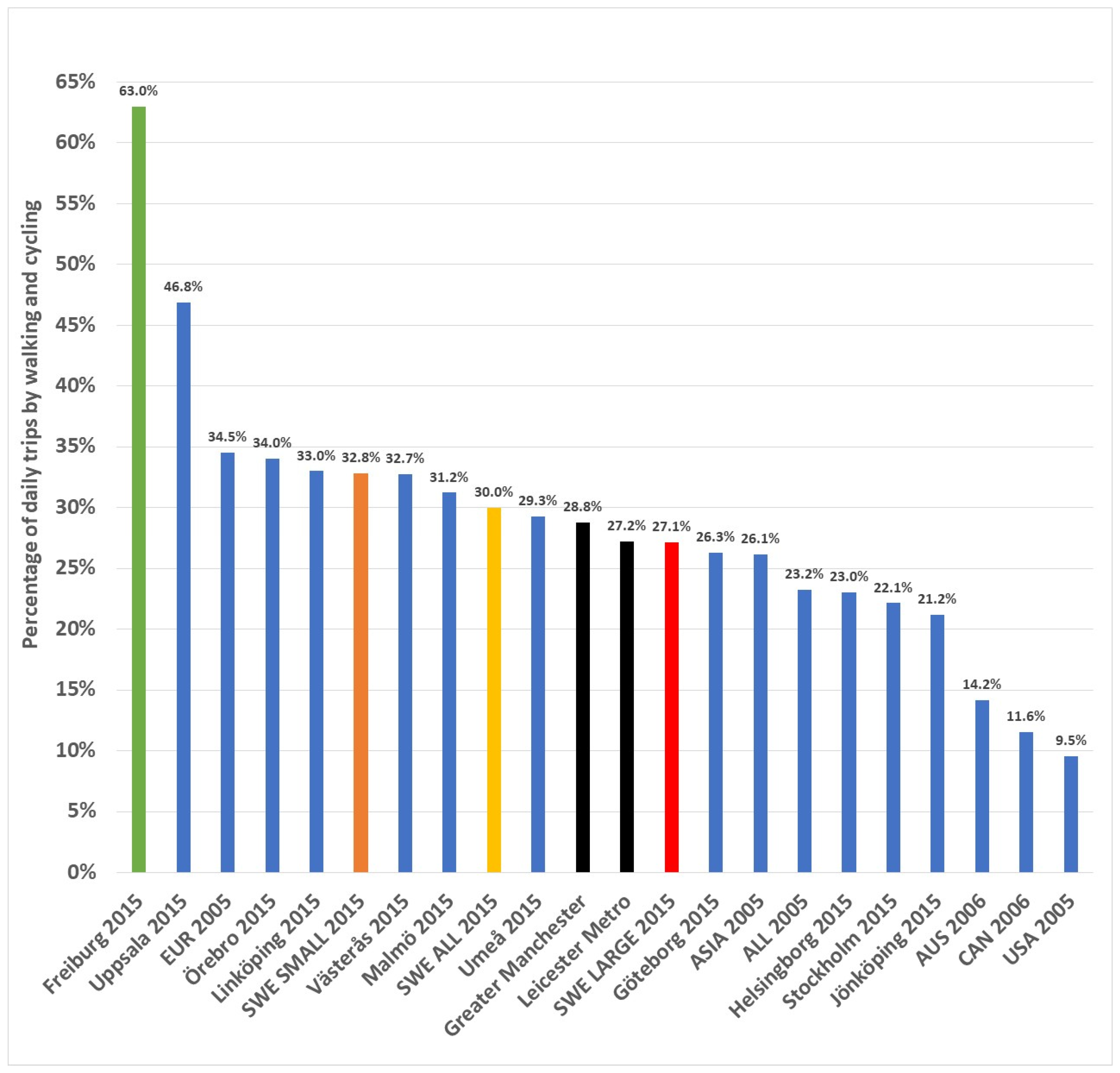
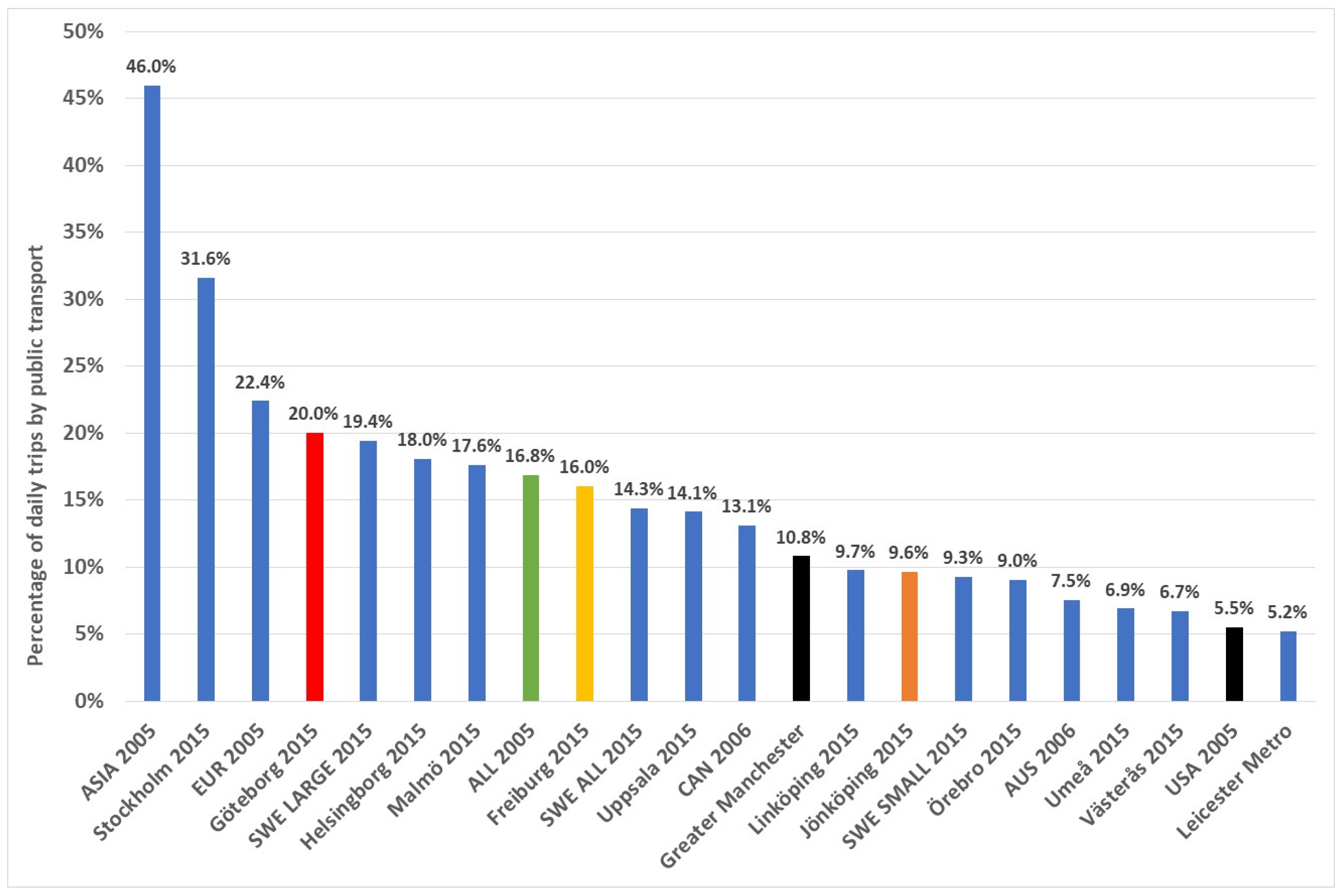
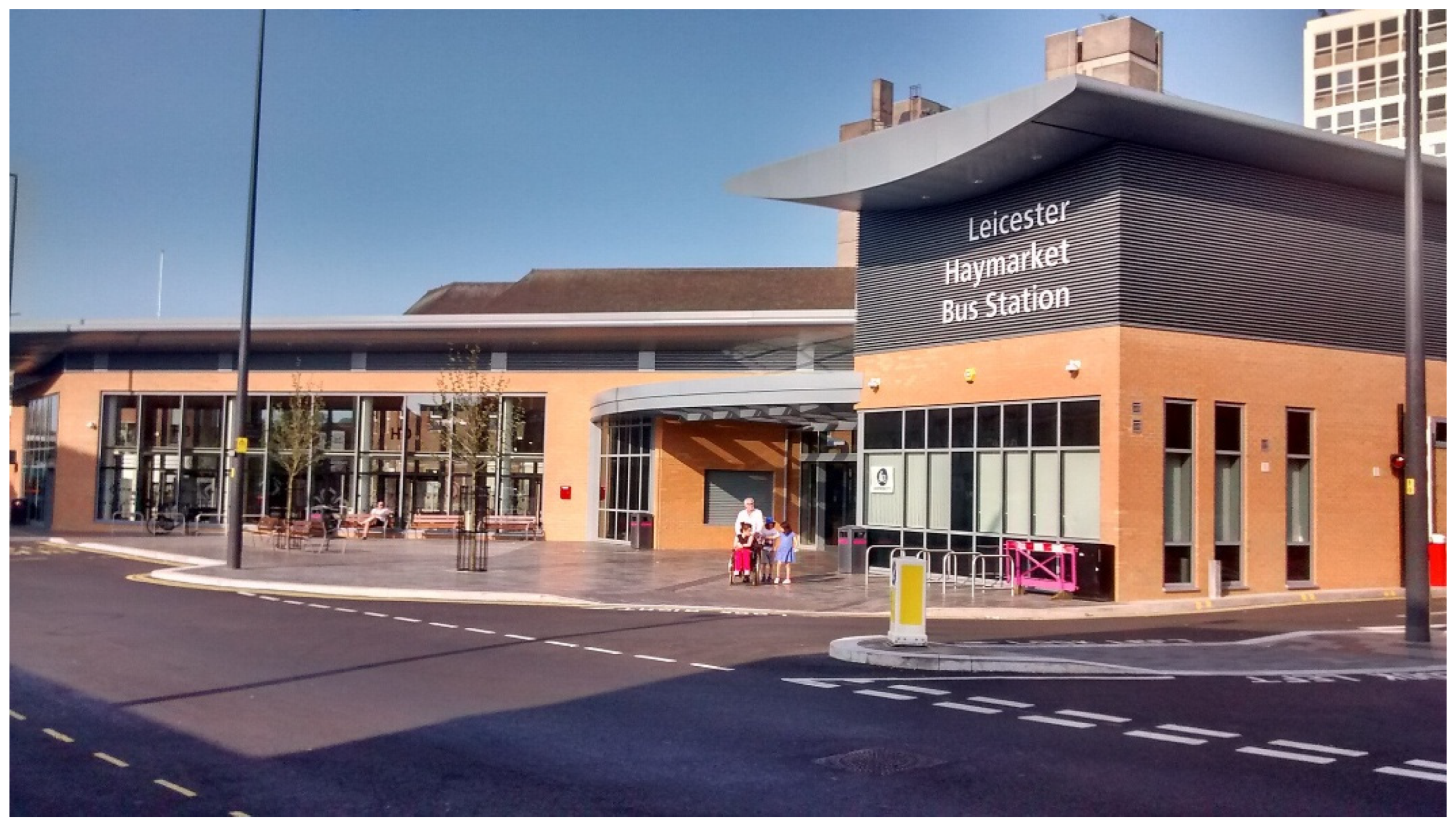
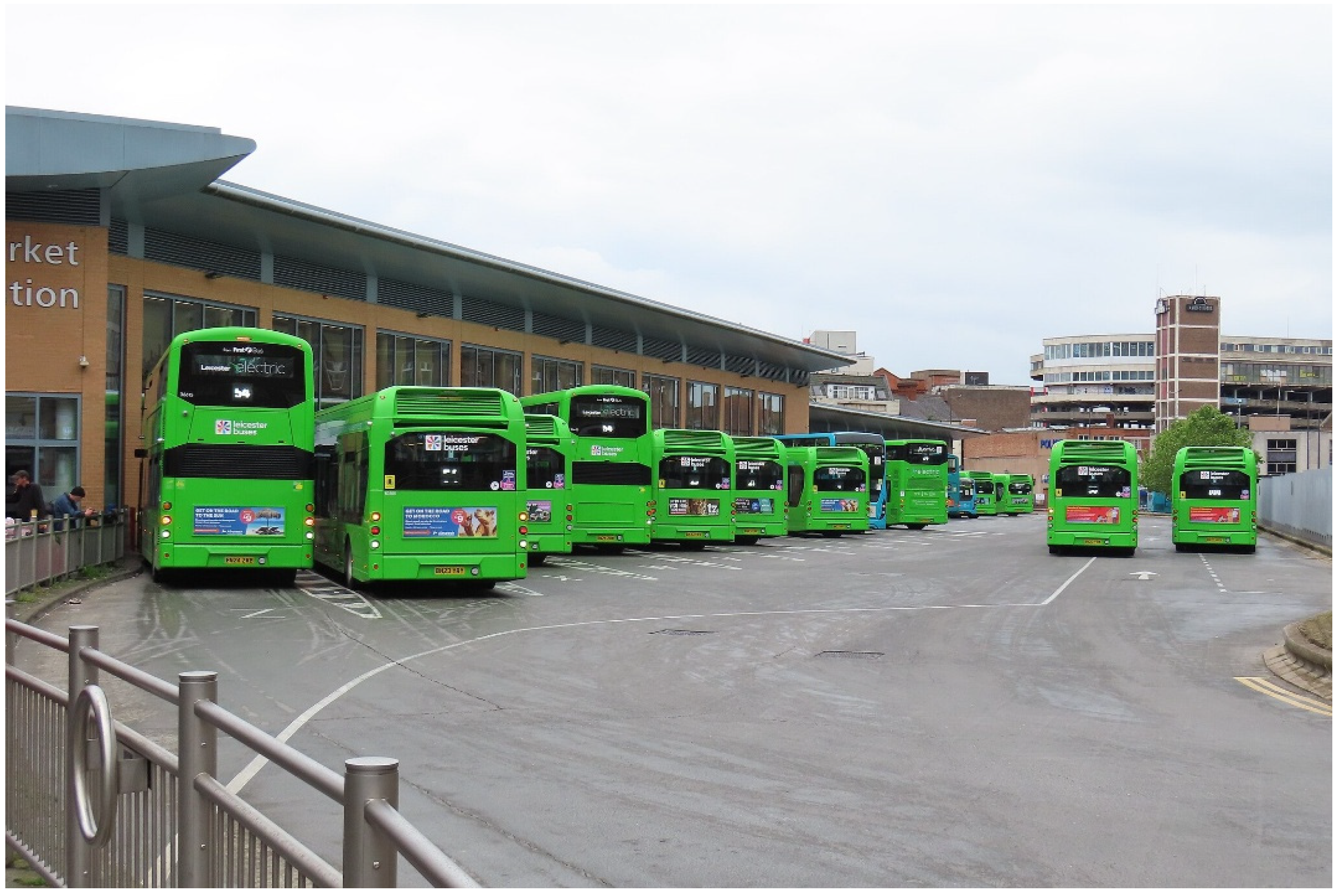
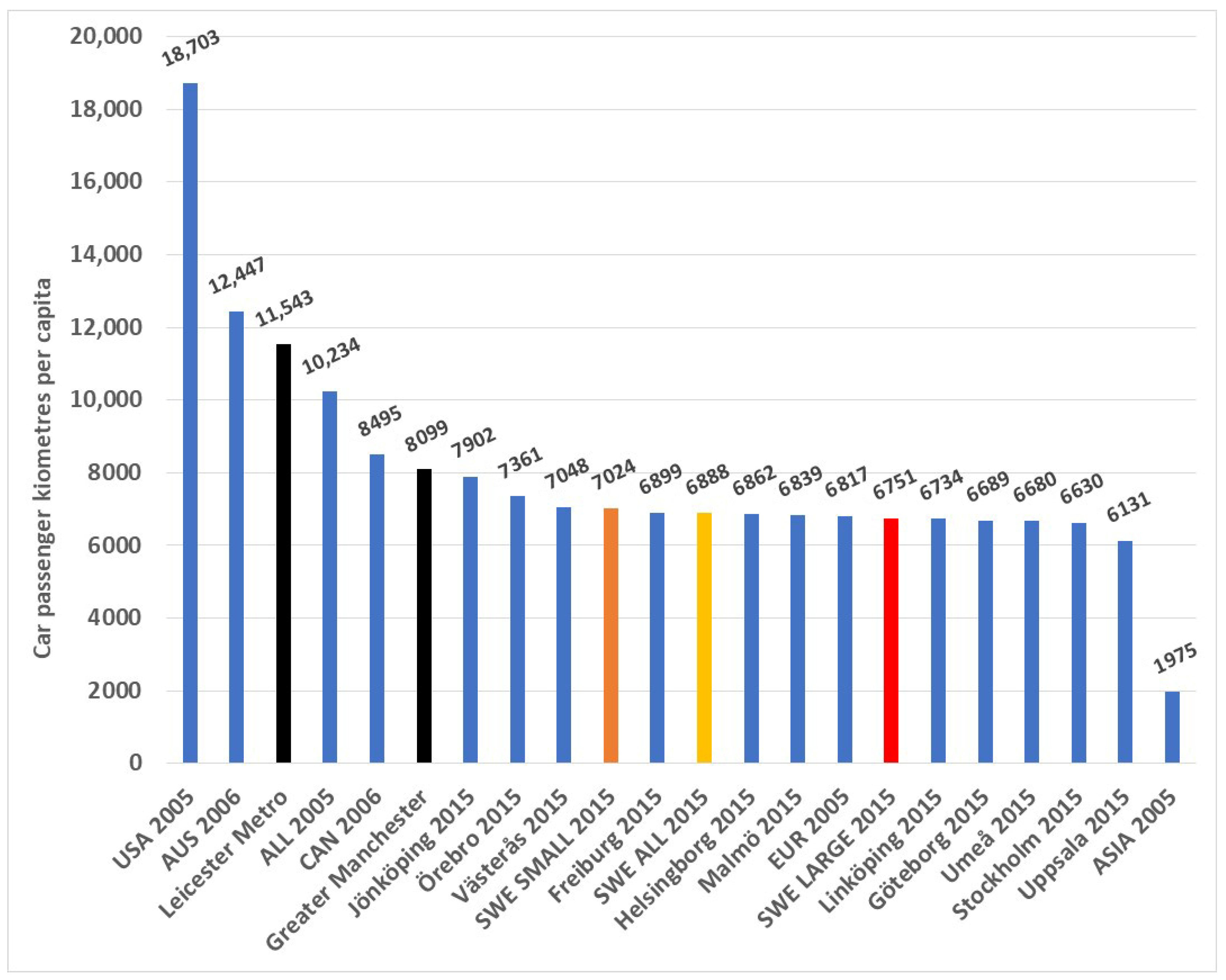
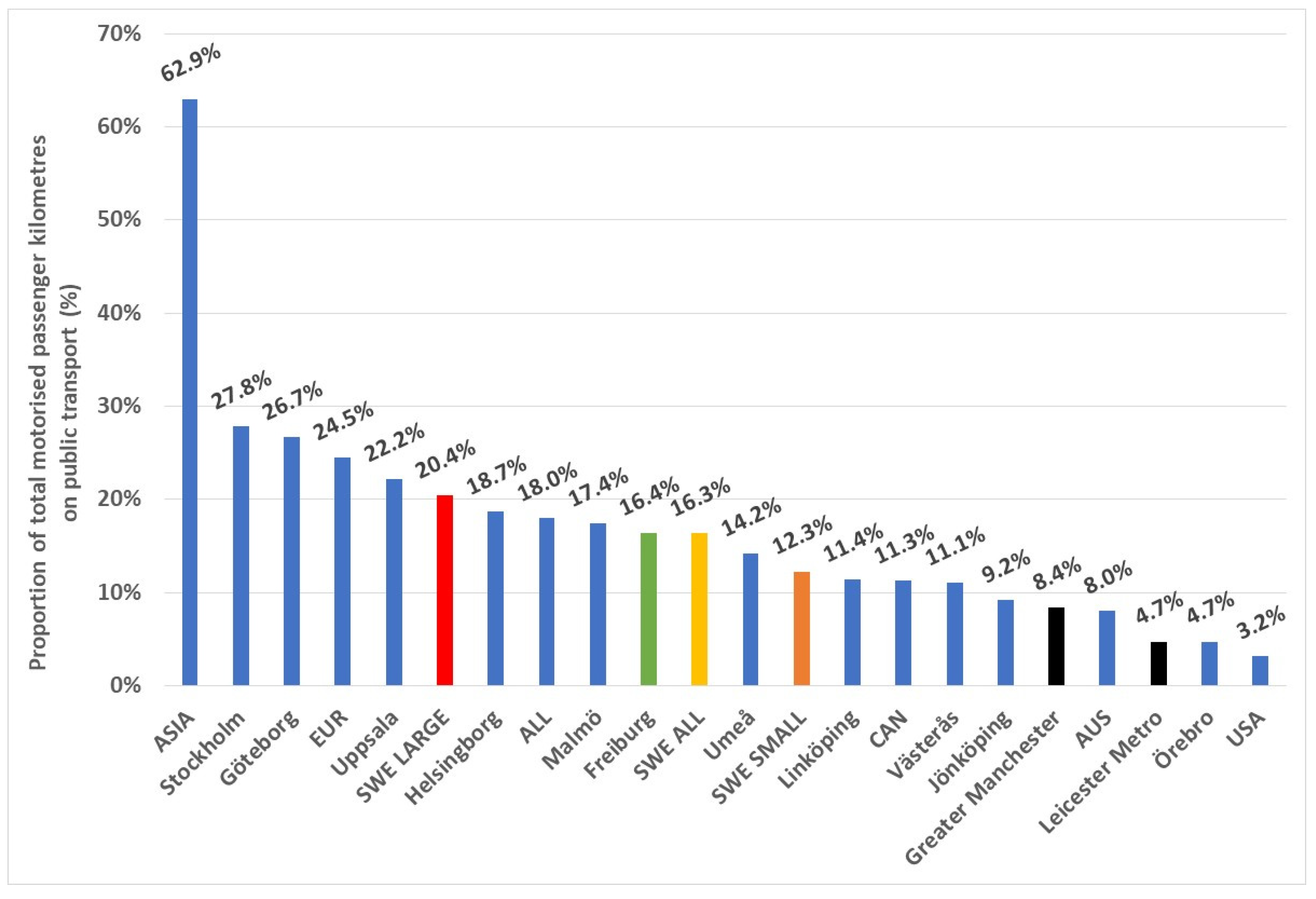
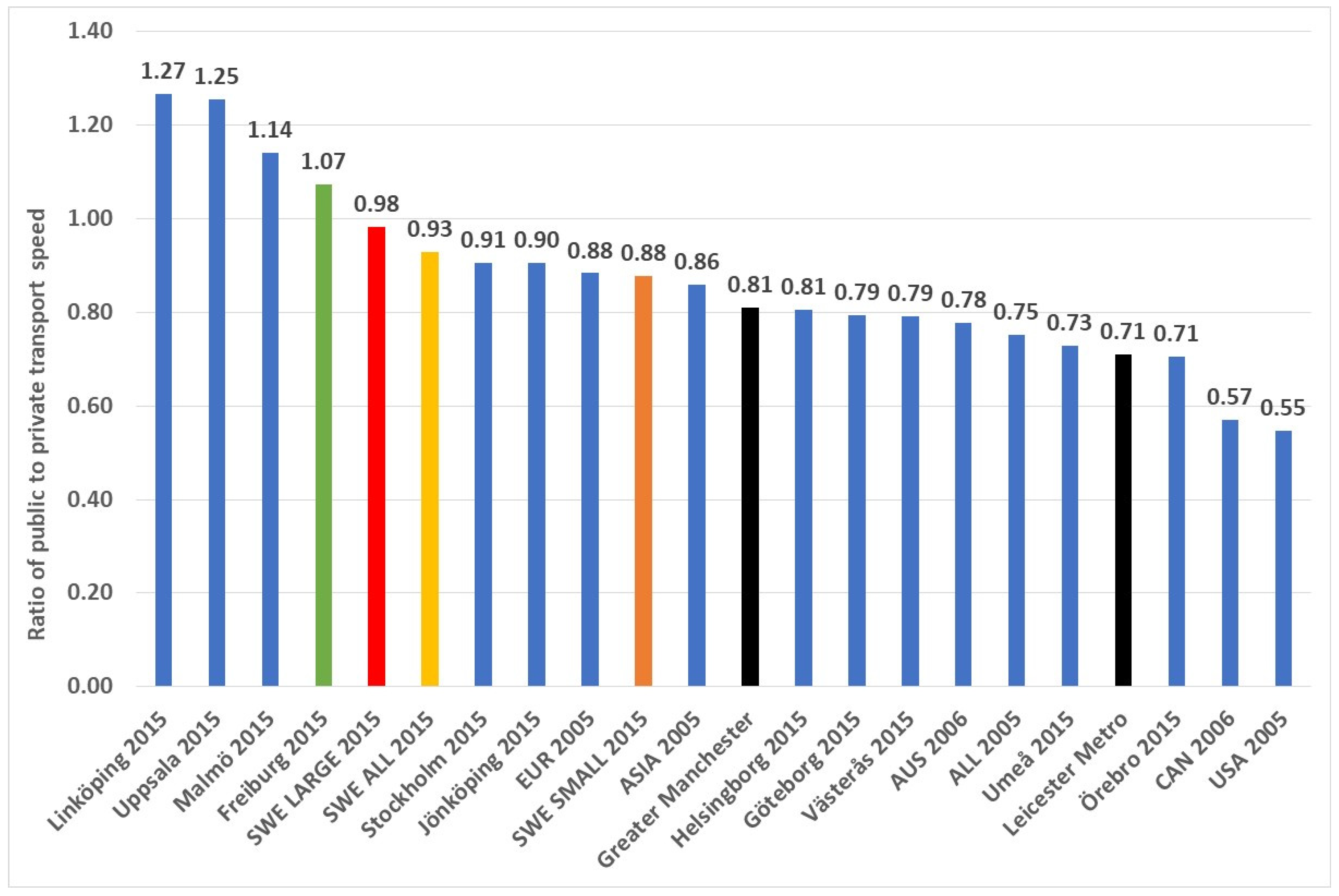
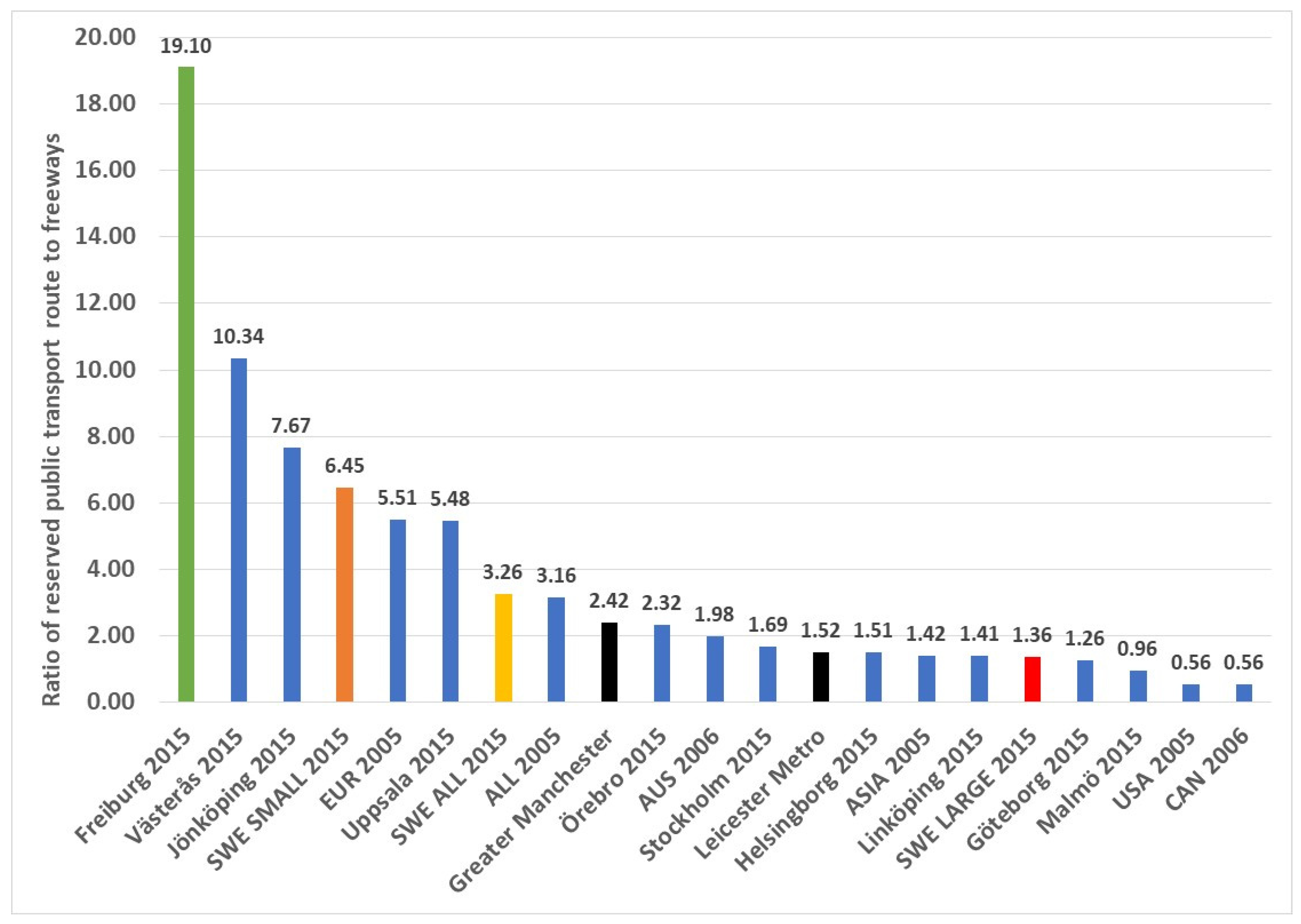
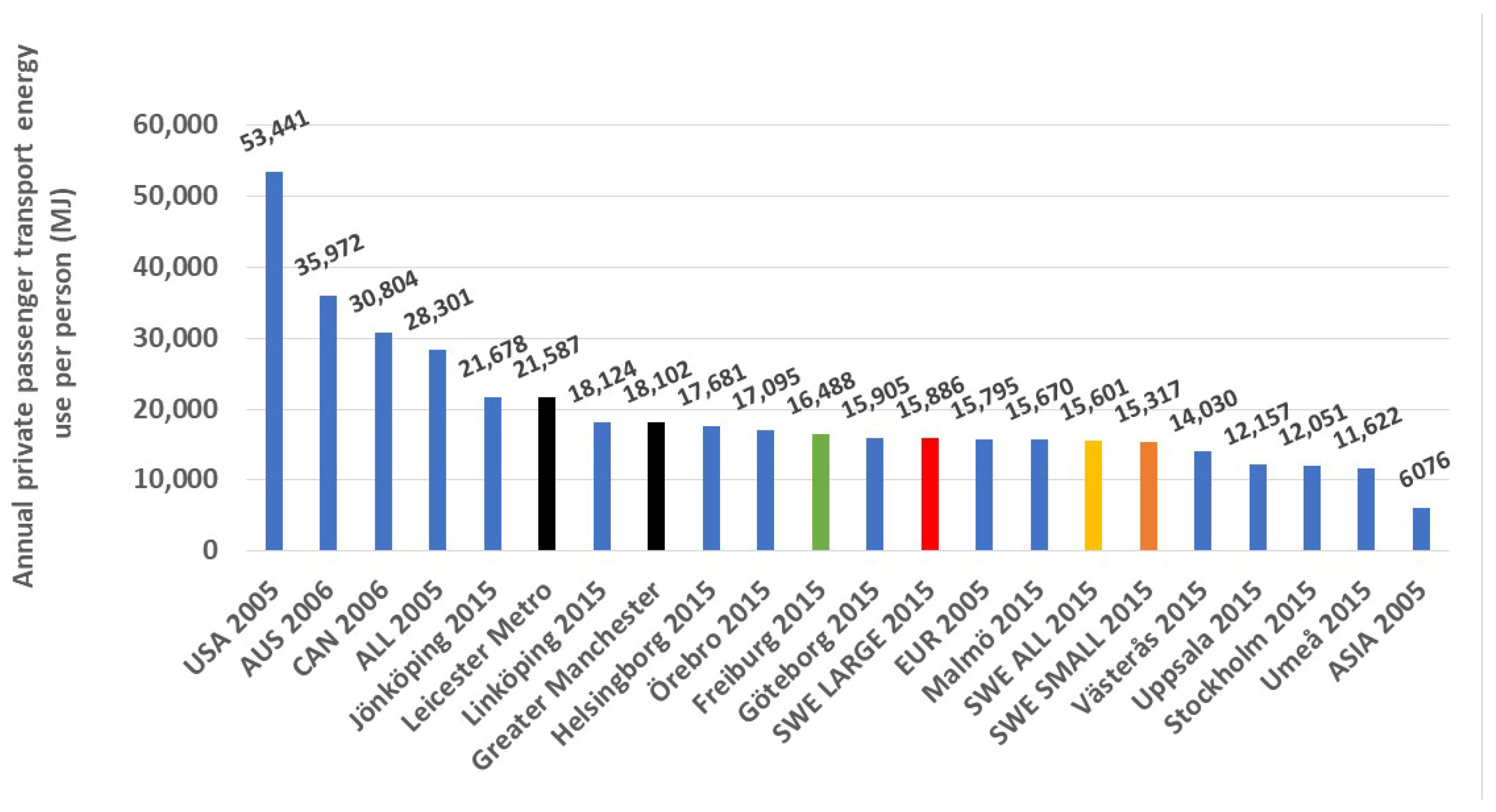
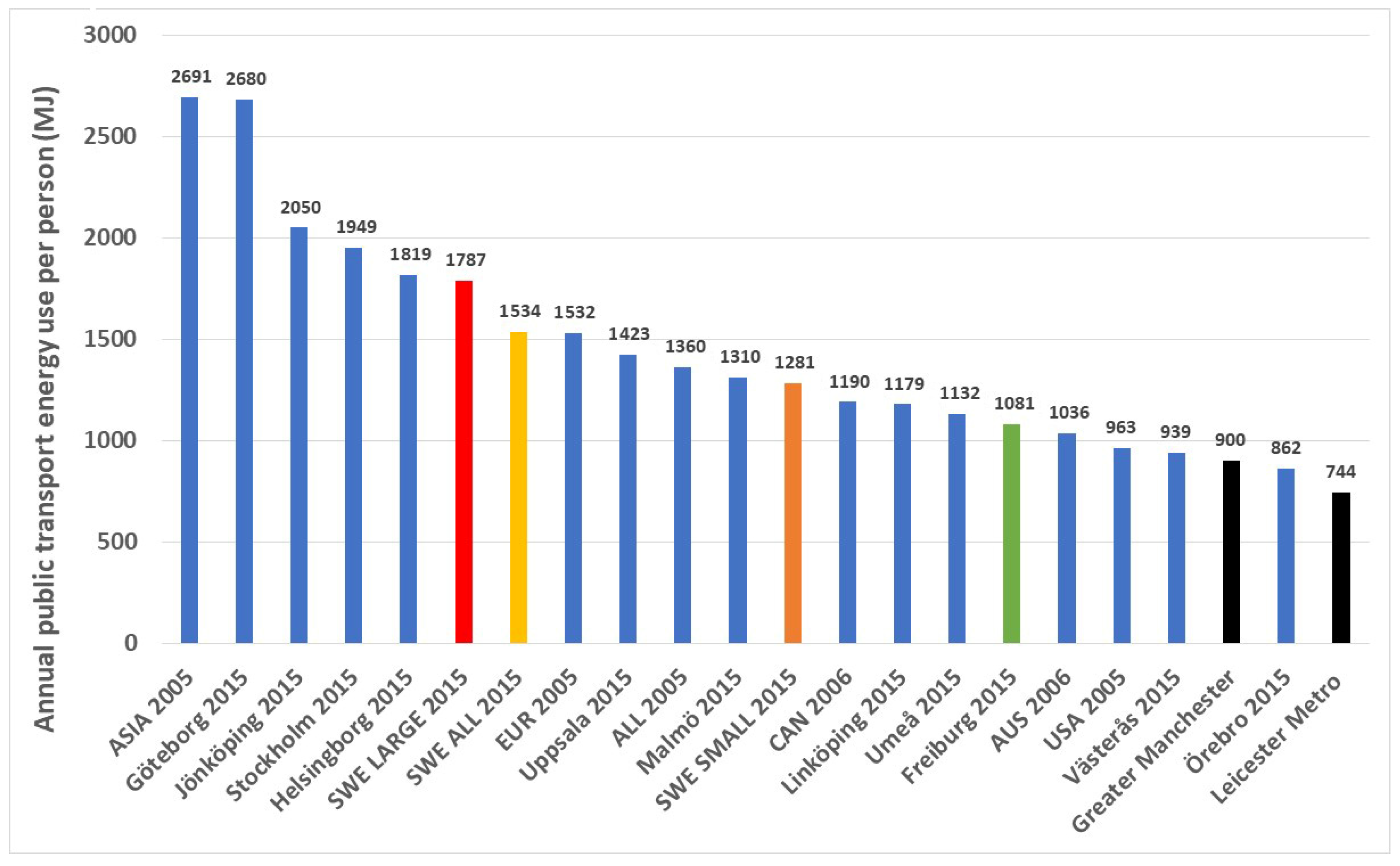
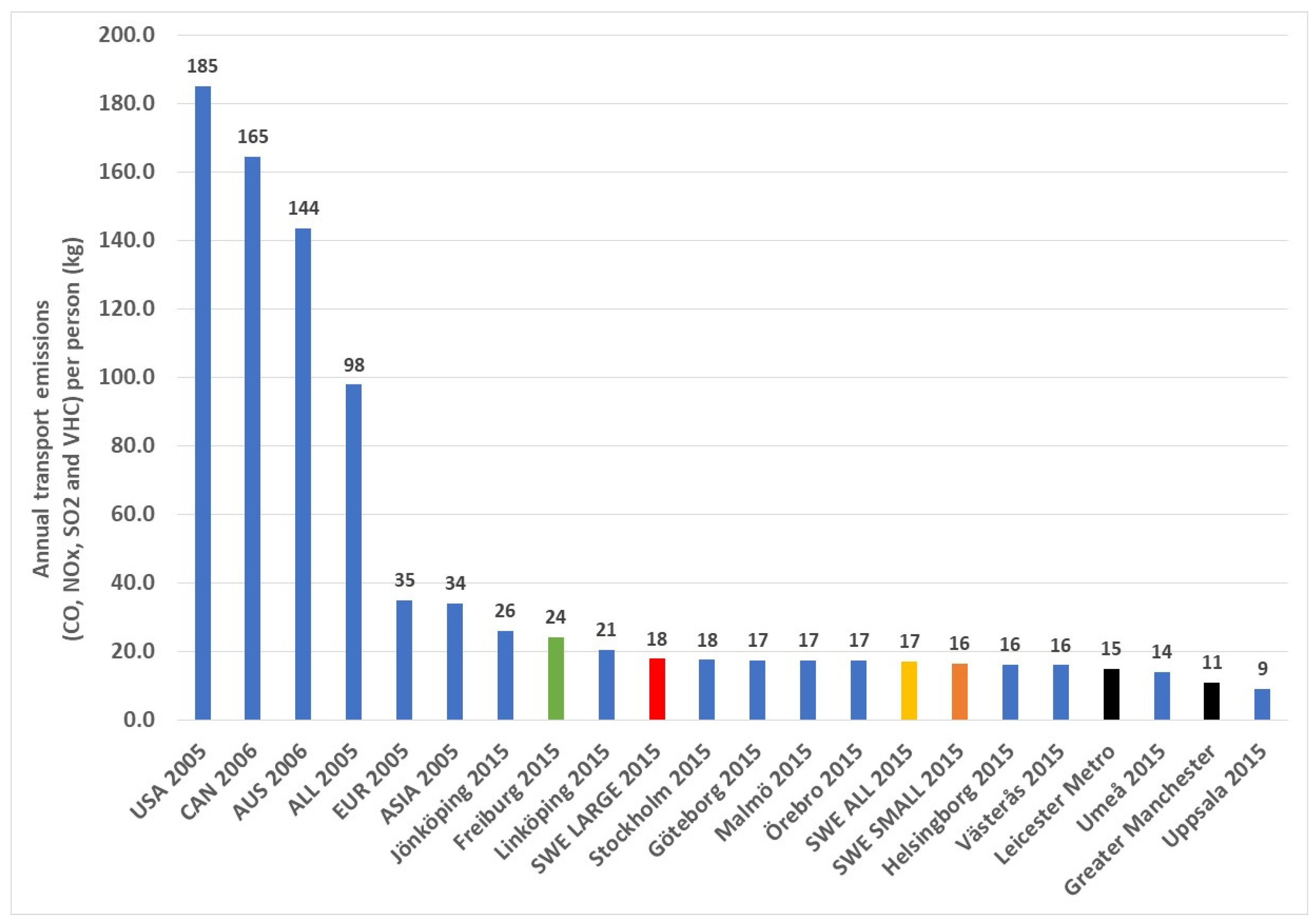
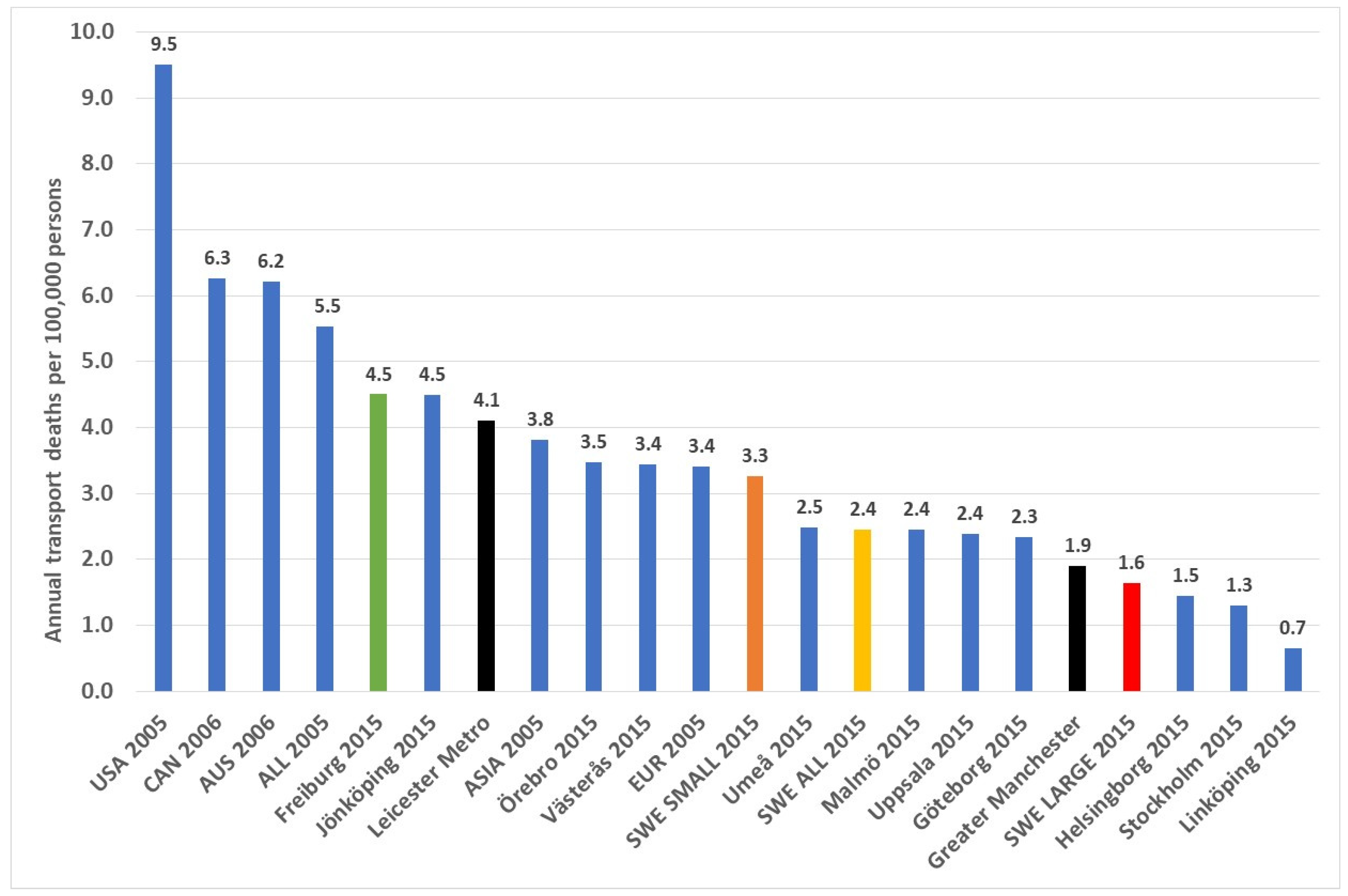
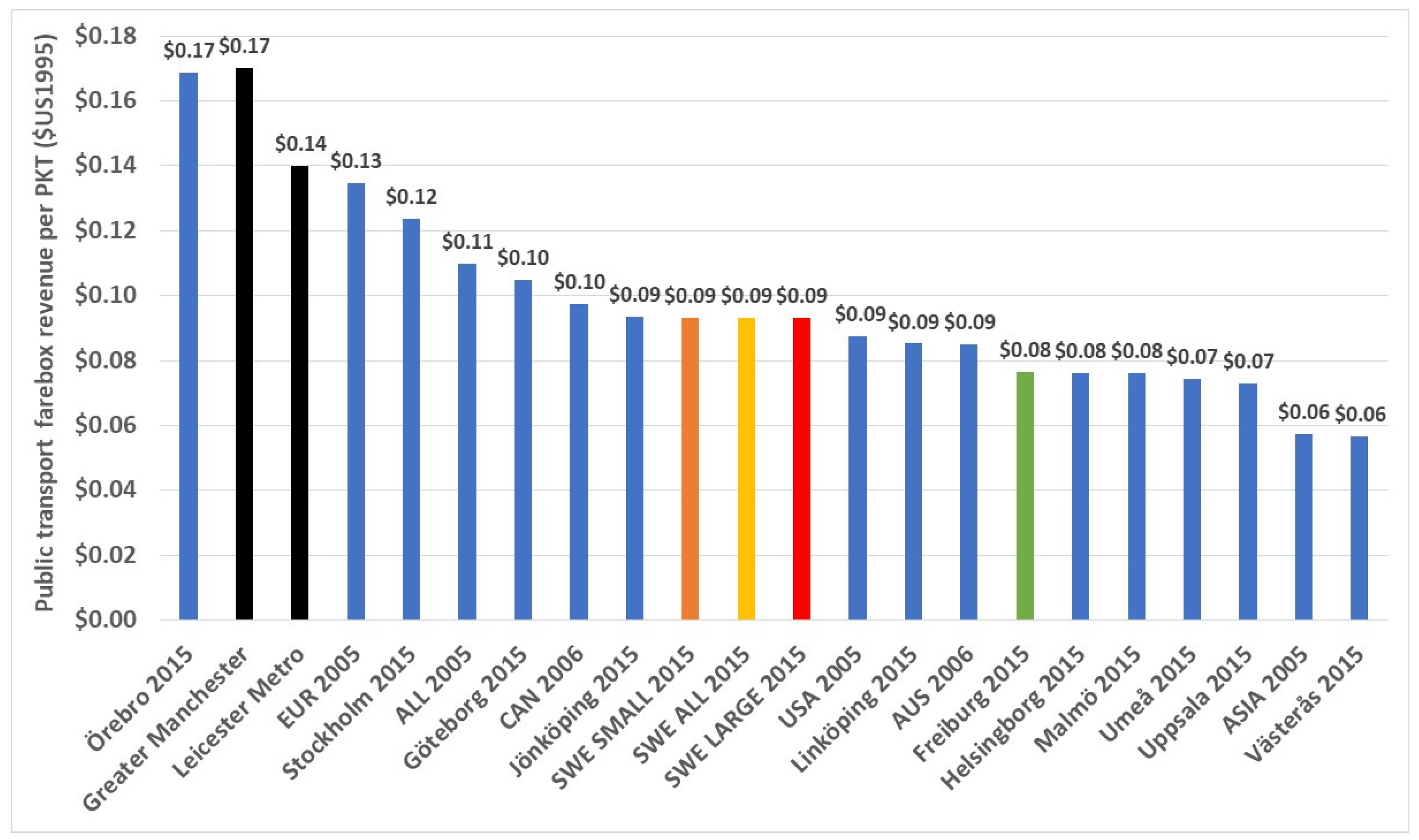
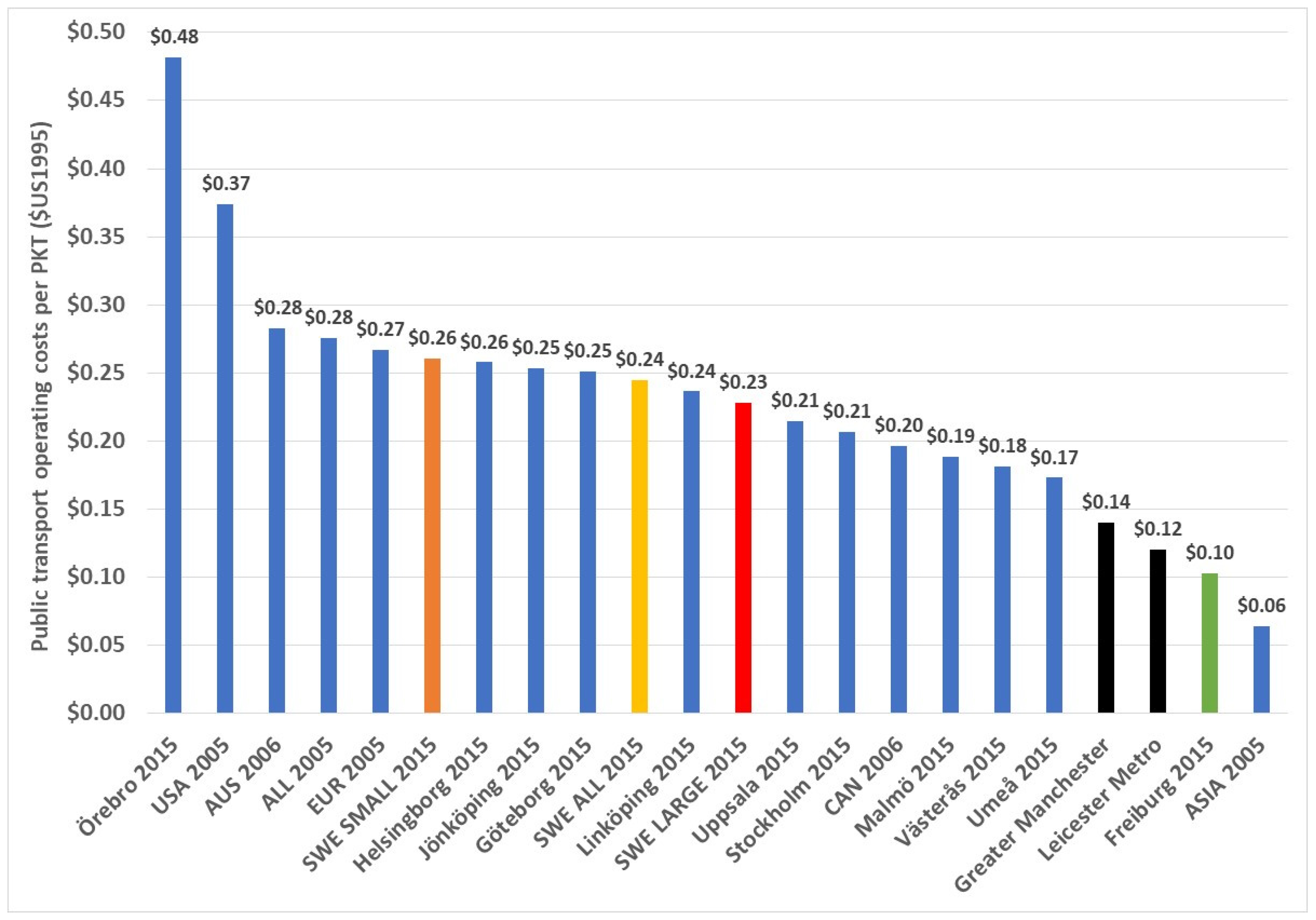
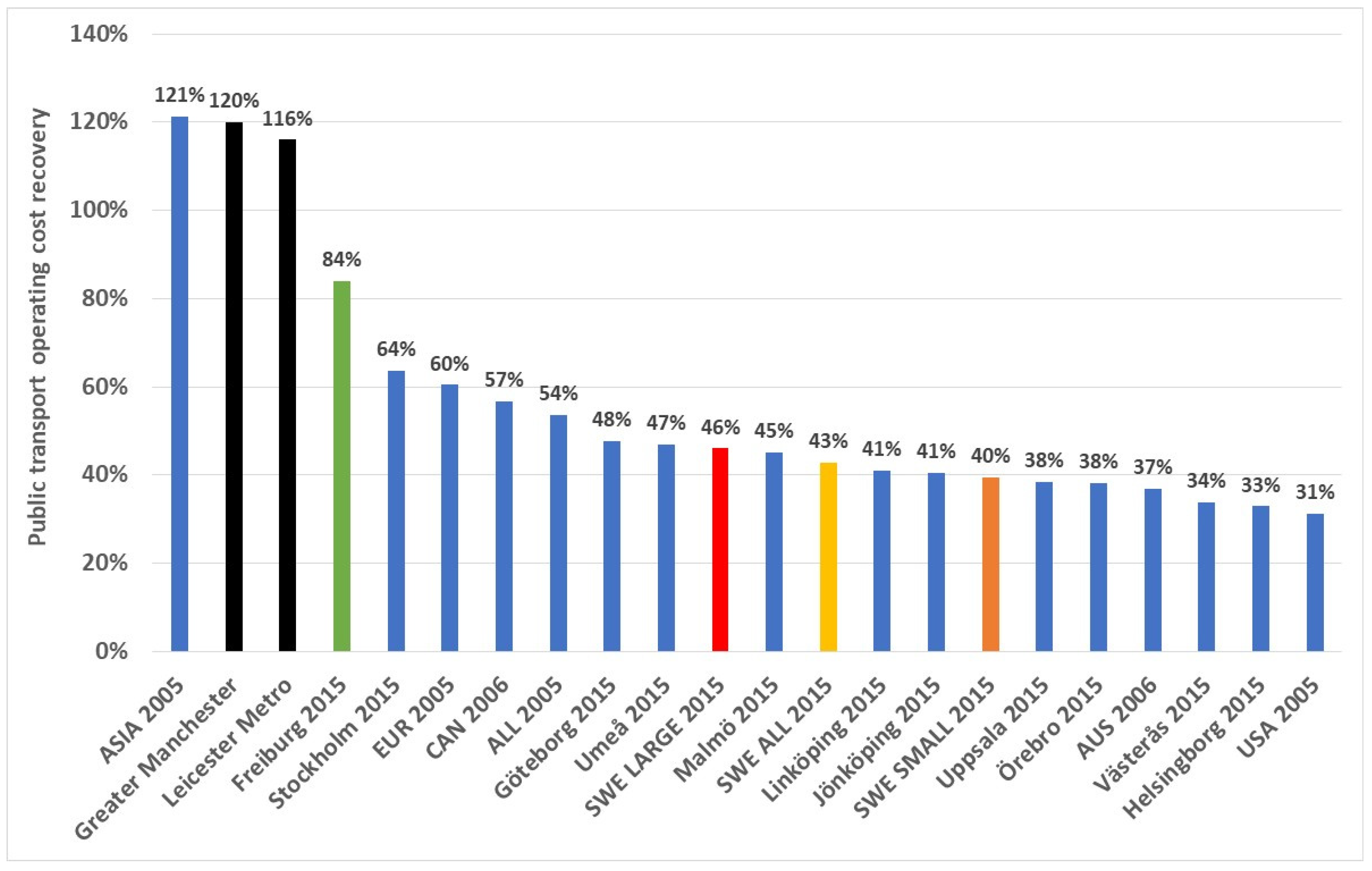
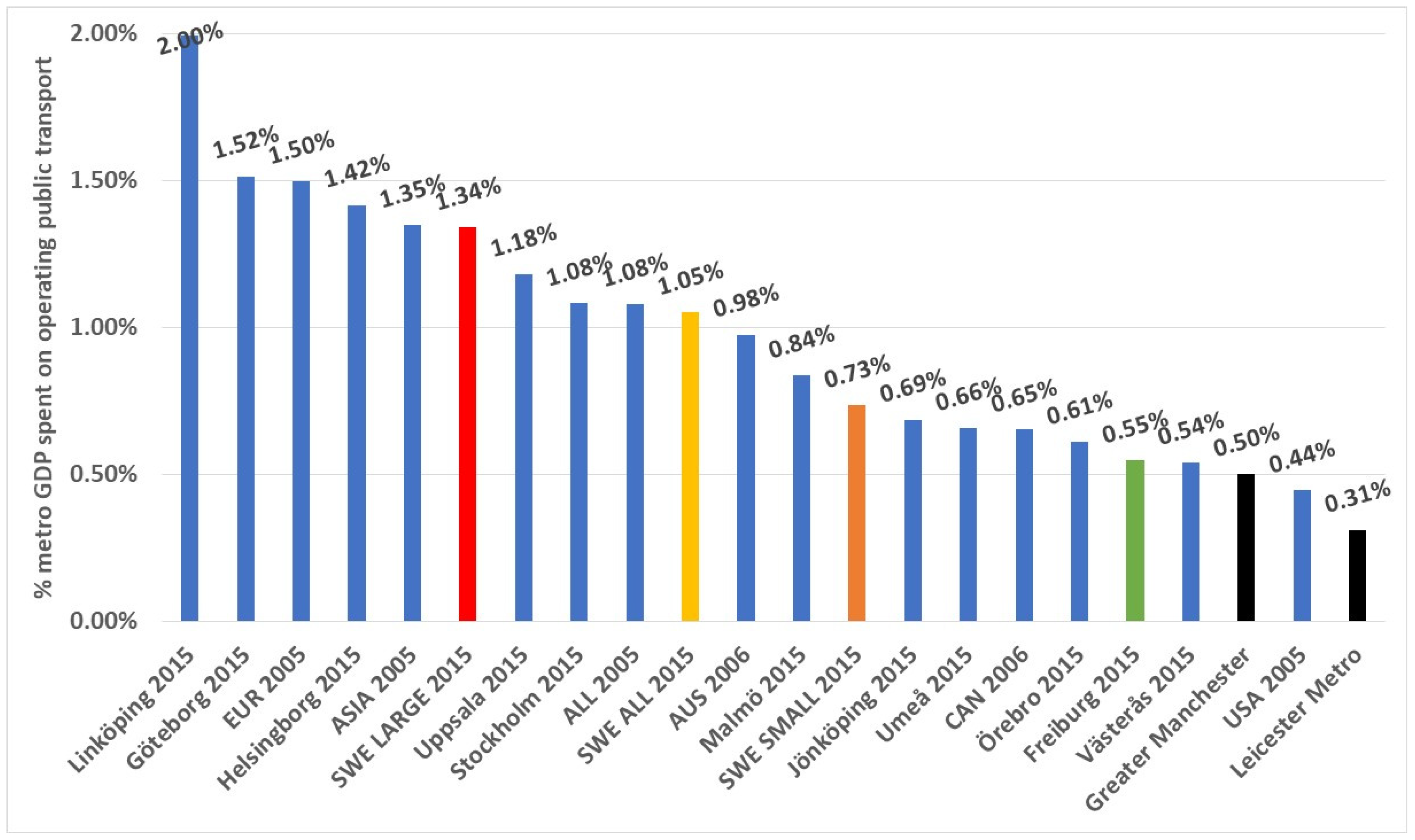
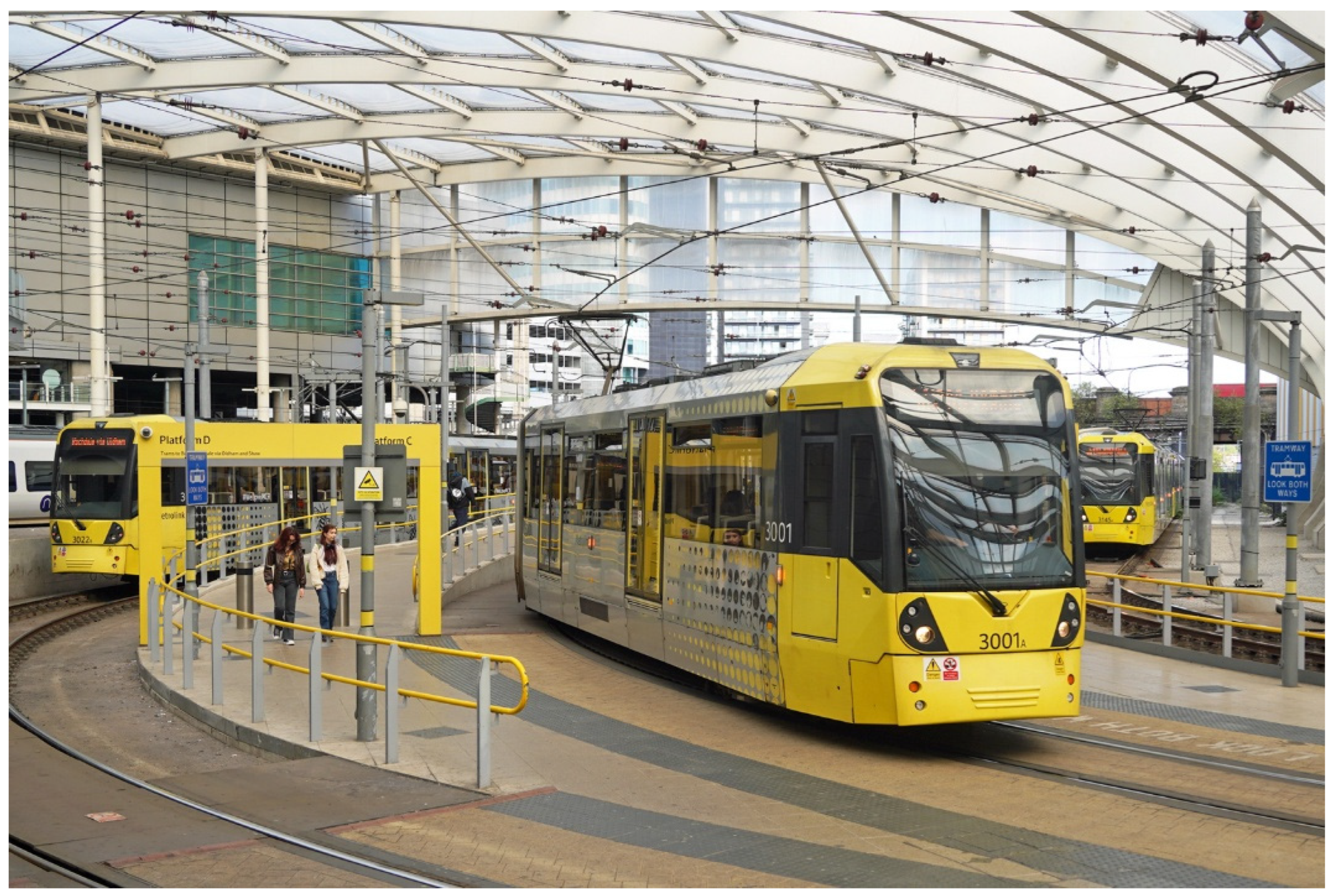
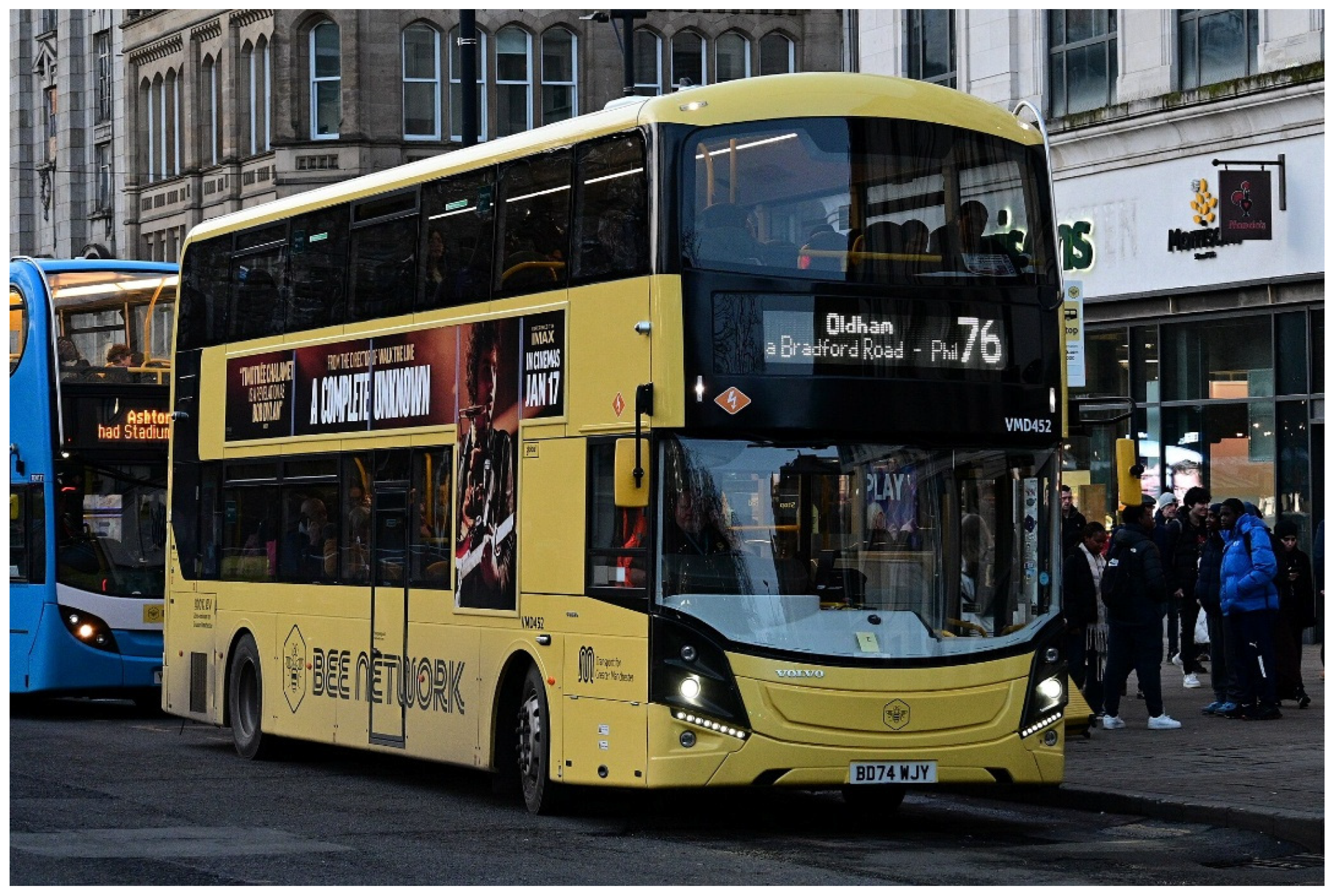
Disclaimer/Publisher’s Note: The statements, opinions and data contained in all publications are solely those of the individual author(s) and contributor(s) and not of MDPI and/or the editor(s). MDPI and/or the editor(s) disclaim responsibility for any injury to people or property resulting from any ideas, methods, instructions or products referred to in the content. |
© 2025 by the author. Licensee MDPI, Basel, Switzerland. This article is an open access article distributed under the terms and conditions of the Creative Commons Attribution (CC BY) license (https://creativecommons.org/licenses/by/4.0/).
Share and Cite
Kenworthy, J.R. Learning from the Best and Worst: Problems, Prospects and Policy Implications from Global Benchmarking of Urban Passenger Transport Sustainability in Greater Manchester and the Leicester Metropolitan Area, UK. Urban Sci. 2025, 9, 370. https://doi.org/10.3390/urbansci9090370
Kenworthy JR. Learning from the Best and Worst: Problems, Prospects and Policy Implications from Global Benchmarking of Urban Passenger Transport Sustainability in Greater Manchester and the Leicester Metropolitan Area, UK. Urban Science. 2025; 9(9):370. https://doi.org/10.3390/urbansci9090370
Chicago/Turabian StyleKenworthy, Jeffrey R. 2025. "Learning from the Best and Worst: Problems, Prospects and Policy Implications from Global Benchmarking of Urban Passenger Transport Sustainability in Greater Manchester and the Leicester Metropolitan Area, UK" Urban Science 9, no. 9: 370. https://doi.org/10.3390/urbansci9090370
APA StyleKenworthy, J. R. (2025). Learning from the Best and Worst: Problems, Prospects and Policy Implications from Global Benchmarking of Urban Passenger Transport Sustainability in Greater Manchester and the Leicester Metropolitan Area, UK. Urban Science, 9(9), 370. https://doi.org/10.3390/urbansci9090370








